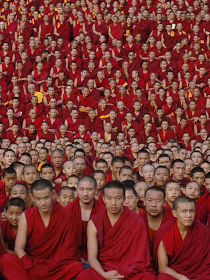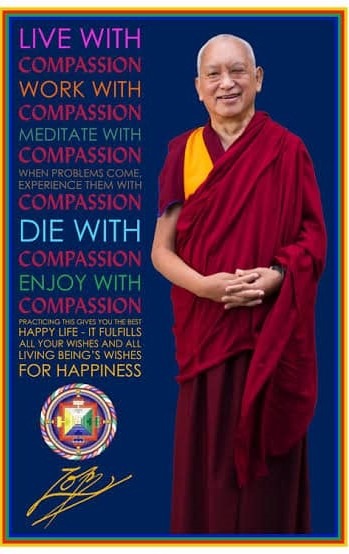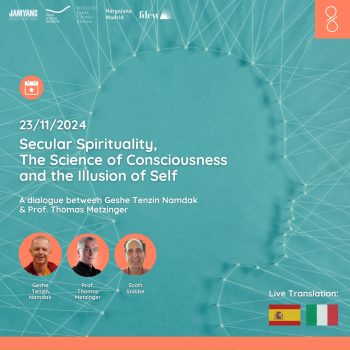- Home
- FPMT Homepage
Foundation for the Preservation of the Mahayana Tradition
The FPMT is an organization devoted to preserving and spreading Mahayana Buddhism worldwide by creating opportunities to listen, reflect, meditate, practice and actualize the unmistaken teachings of the Buddha and based on that experience spreading the Dharma to sentient beings. We provide integrated education through which people’s minds and hearts can be transformed into their highest potential for the benefit of others, inspired by an attitude of universal responsibility and service. We are committed to creating harmonious environments and helping all beings develop their full potential of infinite wisdom and compassion. Our organization is based on the Buddhist tradition of Lama Tsongkhapa of Tibet as taught to us by our founders Lama Thubten Yeshe and Lama Thubten Zopa Rinpoche.
- Willkommen
Die Stiftung zur Erhaltung der Mahayana Tradition (FPMT) ist eine Organisation, die sich weltweit für die Erhaltung und Verbreitung des Mahayana-Buddhismus einsetzt, indem sie Möglichkeiten schafft, den makellosen Lehren des Buddha zuzuhören, über sie zur reflektieren und zu meditieren und auf der Grundlage dieser Erfahrung das Dharma unter den Lebewesen zu verbreiten.
Wir bieten integrierte Schulungswege an, durch denen der Geist und das Herz der Menschen in ihr höchstes Potential verwandelt werden zum Wohl der anderen – inspiriert durch eine Haltung der universellen Verantwortung und dem Wunsch zu dienen. Wir haben uns verpflichtet, harmonische Umgebungen zu schaffen und allen Wesen zu helfen, ihr volles Potenzial unendlicher Weisheit und grenzenlosen Mitgefühls zu verwirklichen.
Unsere Organisation basiert auf der buddhistischen Tradition von Lama Tsongkhapa von Tibet, so wie sie uns von unseren Gründern Lama Thubten Yeshe und Lama Thubten Zopa Rinpoche gelehrt wird.
- Bienvenidos
La Fundación para la preservación de la tradición Mahayana (FPMT) es una organización que se dedica a preservar y difundir el budismo Mahayana en todo el mundo, creando oportunidades para escuchar, reflexionar, meditar, practicar y actualizar las enseñanzas inconfundibles de Buda y en base a esa experiencia difundir el Dharma a los seres.
Proporcionamos una educación integrada a través de la cual las mentes y los corazones de las personas se pueden transformar en su mayor potencial para el beneficio de los demás, inspirados por una actitud de responsabilidad y servicio universales. Estamos comprometidos a crear ambientes armoniosos y ayudar a todos los seres a desarrollar todo su potencial de infinita sabiduría y compasión.
Nuestra organización se basa en la tradición budista de Lama Tsongkhapa del Tíbet como nos lo enseñaron nuestros fundadores Lama Thubten Yeshe y Lama Zopa Rinpoche.
A continuación puede ver una lista de los centros y sus páginas web en su lengua preferida.
- Bienvenue
L’organisation de la FPMT a pour vocation la préservation et la diffusion du bouddhisme du mahayana dans le monde entier. Elle offre l’opportunité d’écouter, de réfléchir, de méditer, de pratiquer et de réaliser les enseignements excellents du Bouddha, pour ensuite transmettre le Dharma à tous les êtres. Nous proposons une formation intégrée grâce à laquelle le cœur et l’esprit de chacun peuvent accomplir leur potentiel le plus élevé pour le bien d’autrui, inspirés par le sens du service et une responsabilité universelle. Nous nous engageons à créer un environnement harmonieux et à aider tous les êtres à épanouir leur potentiel illimité de compassion et de sagesse. Notre organisation s’appuie sur la tradition guéloukpa de Lama Tsongkhapa du Tibet, telle qu’elle a été enseignée par nos fondateurs Lama Thoubtèn Yéshé et Lama Zopa Rinpoché.
Visitez le site de notre Editions Mahayana pour les traductions, conseils et nouvelles du Bureau international en français.
Voici une liste de centres et de leurs sites dans votre langue préférée
- Benvenuto
L’FPMT è un organizzazione il cui scopo è preservare e diffondere il Buddhismo Mahayana nel mondo, creando occasioni di ascolto, riflessione, meditazione e pratica dei perfetti insegnamenti del Buddha, al fine di attualizzare e diffondere il Dharma fra tutti gli esseri senzienti.
Offriamo un’educazione integrata, che può trasformare la mente e i cuori delle persone nel loro massimo potenziale, per il beneficio di tutti gli esseri, ispirati da un’attitudine di responsabilità universale e di servizio.
Il nostro obiettivo è quello di creare contesti armoniosi e aiutare tutti gli esseri a sviluppare in modo completo le proprie potenzialità di infinita saggezza e compassione.
La nostra organizzazione si basa sulla tradizione buddhista di Lama Tsongkhapa del Tibet, così come ci è stata insegnata dai nostri fondatori Lama Thubten Yeshe e Lama Zopa Rinpoche.
Di seguito potete trovare un elenco dei centri e dei loro siti nella lingua da voi prescelta.
- 欢迎 / 歡迎
简体中文
“护持大乘法脉基金会”( 英文简称:FPMT。全名:Foundation for the Preservation of the Mahayana Tradition) 是一个致力于护持和弘扬大乘佛法的国际佛教组织。我们提供听闻,思维,禅修,修行和实证佛陀无误教法的机会,以便让一切众生都能够享受佛法的指引和滋润。
我们全力创造和谐融洽的环境, 为人们提供解行并重的完整佛法教育,以便启发内在的环宇悲心及责任心,并开发内心所蕴藏的巨大潜能 — 无限的智慧与悲心 — 以便利益和服务一切有情。
FPMT的创办人是图腾耶喜喇嘛和喇嘛梭巴仁波切。我们所修习的是由两位上师所教导的,西藏喀巴大师的佛法传承。
繁體中文
護持大乘法脈基金會”( 英文簡稱:FPMT。全名:Found
ation for the Preservation of the Mahayana Tradition ) 是一個致力於護持和弘揚大乘佛法的國際佛教組織。我們提供聽聞, 思維,禪修,修行和實證佛陀無誤教法的機會,以便讓一切眾生都能 夠享受佛法的指引和滋潤。 我們全力創造和諧融洽的環境,
為人們提供解行並重的完整佛法教育,以便啟發內在的環宇悲心及責 任心,並開發內心所蘊藏的巨大潛能 — 無限的智慧與悲心 – – 以便利益和服務一切有情。 FPMT的創辦人是圖騰耶喜喇嘛和喇嘛梭巴仁波切。
我們所修習的是由兩位上師所教導的,西藏喀巴大師的佛法傳承。 察看道场信息:
- FPMT Homepage
- News/Media
-
- Study & Practice
-
-
- About FPMT Education Services
- Latest News
- Programs
- New to Buddhism?
- Buddhist Mind Science: Activating Your Potential
- Heart Advice for Death and Dying
- Discovering Buddhism
- Living in the Path
- Exploring Buddhism
- FPMT Basic Program
- FPMT Masters Program
- FPMT In-Depth Meditation Training
- Maitripa College
- Lotsawa Rinchen Zangpo Translator Program
- Universal Education for Compassion & Wisdom
- Online Learning Center
-
- Prayers & Practice Materials
- Overview of Prayers & Practices
- Full Catalogue of Prayers & Practice Materials
- Explore Popular Topics
- Benefiting Animals
- Chenrezig Resources
- Death & Dying Resources
- Lama Chopa (Guru Puja)
- Lama Zopa Rinpoche: Compendium of Precious Instructions
- Lama Zopa Rinpoche: Life Practice Advice
- Lama Zopa Rinpoche Practice Series
- Lamrim Resources
- Mantras
- Prayer Book Updates
- Purification Practices
- Sutras
- Thought Transformation (Lojong)
- Audio Materials
- Dharma Dates - Tibetan Calendar
- Translation Services
- Publishing Services
- Ways to Offer Support
- Prayers & Practice Materials
-
- Teachings and Advice
- Find Teachings and Advice
- Lama Zopa Rinpoche Advice Page
- Lama Zopa Rinpoche: Compendium of Precious Instructions
- Lama Zopa Rinpoche Video Teachings
- ༧སྐྱབས་རྗེ་བཟོད་པ་རིན་པོ་ཆེ་མཆོག་ནས་སྩལ་བའི་བཀའ་སློབ་བརྙན་འཕྲིན།
- Podcasts
- Lama Yeshe Wisdom Archive
- Buddhism FAQ
- Dharma for Young People
- Resources on Holy Objects
- Teachings and Advice
-
-
*If a menu item has a submenu clicking once will expand the menu clicking twice will open the page.
-
-
- Centers
-
- Teachers
-
- Projects
-
-
-
-
*If a menu item has a submenu clicking once will expand the menu clicking twice will open the page.
-
-
- FPMT
-
-
-
-
-
Good human qualities… honesty, sincerity, a good heart, cannot be bought with money, nor can they be produced by machines, but only by the mind itself. We call this the inner light, or God’s blessing, or human quality. This is the essence of mankind.
His Holiness the Dalai Lama
-
-
-
- Shop
-
-
-
The Foundation Store is FPMT’s online shop and features a vast selection of Buddhist study and practice materials written or recommended by our lineage gurus. These items include homestudy programs, prayers and practices in PDF or eBook format, materials for children, and other resources to support practitioners.
Items displayed in the shop are made available for Dharma practice and educational purposes, and never for the purpose of profiting from their sale. Please read FPMT Foundation Store Policy Regarding Dharma Items for more information.
-
-
FPMT Community: Stories & News
10
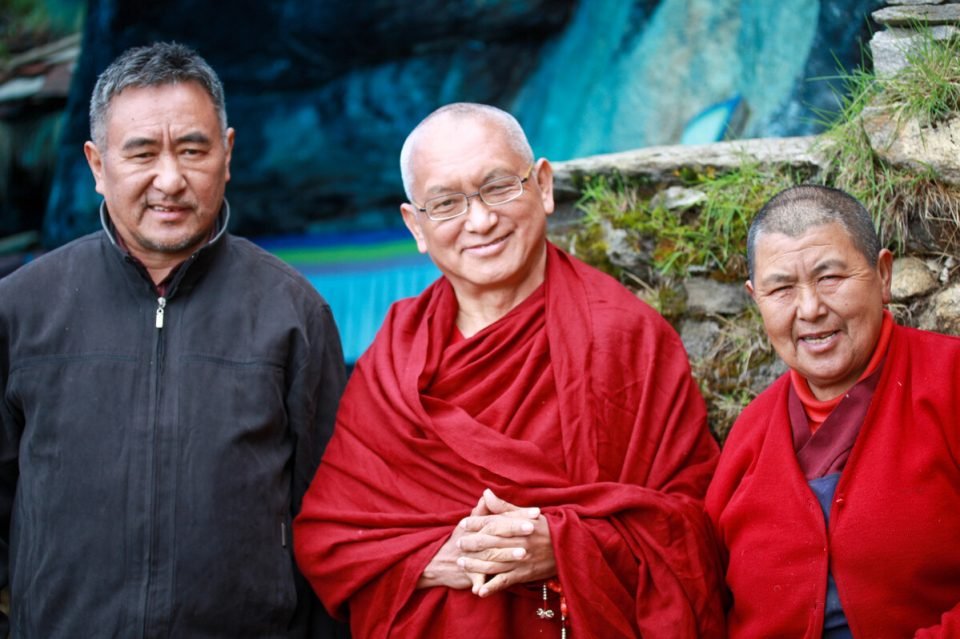
Lama Zopa Rinpoche with brother Sangay Sherpa (left), and sister Ani Samten (right), Lawudo, Nepal, June 2008. Photo by Ven. Thubten Kunsang.
Sangay Sherpa, the brother of Lama Zopa Rinpoche, passed away on December 8, 2024 after an admittance to HAMS hospital in Kathmandu for various health issues. Sangay offered a lifetime of service to Lama Zopa Rinpoche, His Holiness the Dalai Lama, and the Lawudo Retreat Center. The cremation will take place on December 11 at Ramadoli Teku in Kathmandu.
In 2022, Frances Howland wrote a moving biography of Sangay, and we invite you to read it now. Please rejoice in Sangay’s beneficial life, recall his kindness, and to also pray for him to never be reborn in the lower realms, to be born in a pure land where he can be enlightened, or to receive a perfect human body, meet the Mahayana teachings, and meet a perfectly qualified guru, and by only pleasing the guru’s mind, to achieve enlightenment as quickly as possible. It is also requested that those who are able to please recite at least one mala of OM MANI PADME HUM and/or The King of Prayers for Sangay at this very important time.

Lama Zopa Rinpoche and his brother Sangay Sherpa and Sangye’s wife, Nyima. March 2021, Kathmanu, Nepal. Photo by Ven. Roger Kunsang.
Rejoicing in the Achievements of Sangay Sherpa
By Frances Howland, written in 2022
Sangay is the younger brother of Kyabje Lama Zopa Rinpoche and his sister Ven. Ngawang Samten. He was born in 1948 in the village of Thame in Solu Khumbu, one month after their father died. They were a poor Sherpa family, and the early years were filled with many hardships due to their father’s untimely death.
In 2008 Lama Zopa Rinpoche requested Sangay to become the director of Lawudo Retreat Centre and for the next 13 years he worked hard raising money and maintaining and developing Lawudo Retreat Centre in accordance with the wishes of Lama Zopa Rinpoche.
The immediate advice from Rinpoche was to tear down the old monastery and build a new, larger gompa that could accommodate 500 monks. Built in 1968 it was in an extremely poor condition and at risk of collapse at any time. The building was sinking into the ground, the front pillars were crooked, and the walls were visibly leaning outwards. However, the senior Lama from Thame monastery, Lama Zopa’s uncle Ashang Yonden, and other Lamas recommended that the old gompa should be preserved as a pilgrimage site because Lama Zopa and Lama Yeshe themselves had supervised and planned the construction and carried some of the stones used in the building. Following this input, Sangay decided to reinforce the foundations with concrete while adding concrete beams and pillars in strategic places, while keeping the original building.
The difficulties of building in the Khumbu region cannot be stressed enough. In 1976 the Khumbu region became the Sagarmatha National Park and was declared a World Heritage Site. Everything must be carried or flown into the area. Even wood used for building cannot be cut from local trees. Sangay had to organize cargo helicopters to carry all the materials he used for all the projects he undertook. This also increased the cost substantially with each helicopter costing around 3,000 US dollars plus the porter charges to carry the goods from the Syangboche airstrip to Lawudo. Despite these challenges, new guest rooms, a new kitchen, major renovations and extensions to the existing buildings plus the construction of a library with a balcony overlooking the valley were all completed. The logistics of all of these projects are mind-boggling.
In late March 2015 a group of us accompanied Rinpoche to Lawudo. Sangay and Ven. Ngawang Samten hosted everyone and there was a big opening ceremony for the new library building, with a procession of monks from a nearby monastery. On April 25th, Lama Zopa Rinpoche had just left Lawudo to return to Kathmandu when a major earthquake measuring 7.6 shook Nepal. No one in Lawudo or the surrounding villages died but most buildings and many stupas on the trails were damaged. At Lawudo the impact was severe. There were cracks in the gompa, the dining room roof fell down, the toilets collapsed, the stone walls of every building cracked open, and the new library where we had just had the opening ceremony was cracked with many stones fallen. Sangay immediately organized an Earthquake Relief for Damage at Lawudo to help fund the repairs.
Another task that Lama Zopa gave his brother was to install a 22 feet-high Padmasambhava statue in the gompa at Lawudo. In the standing aspect of Sampa Lhundrup, it was to face eastwards and be surrounded by seven life sized manifestations, all cast in copper with gold finishing. Sangay commissioned the statues from the skilled Sakya artisans of Patan down in the Kathmandu valley. On 27 June 2016 the statues were helicoptered into Mende, the hamlet closest to Lawudo. Thirty-five Sherpas were needed simply to carry the main statue up the steep mountainside to Lawudo.
In May 2021 a pilgrimage to Lawudo was organized for Lama Zopa and a group of students. Sangay and Ven. Nyima Tashi spent months in Lawudo making sure all the building work was completed and the statues were ready to be consecrated. By then the COVID pandemic was in its second year, and by May the Delta variant was claiming lives in Nepal and India. Once again Nepal went into a total lockdown and the visit to Lawudo was cancelled. Nevertheless Sangay and his team continued undaunted with their extensive program of repairs and upgrades. These included introducing a damp course for the Lawudo cave, building a support wall behind the monastery building, and installing safer steps and walkways for the increasingly elderly Lawudo family.
Another extraordinary achievement from Sangay’s time as Lawudo director was to bring fresh running water to Lawudo and 38 other households in the valley. Anyone who has been to Lawudo will know what an extraordinary feat of engineering would be necessary for such a project. The water is piped at 1.7 litres per second from a height of 4500m through a pipe clamped to the vertical rock faces above. The pipeline was inaugurated in November 2019 and is making an incalculable contribution to the health and well-being of the local population and its livestock. The budget was millions of rupees, much of which was fundraised by Sangay.
Before dedicating his time to Lawudo, Sangay was a successful businessman, and was also involved in the trekking and tourism business. He lives in Chabhil not far from the Boudha stupa with his wife Nyima, his airline pilot son Pemba, and his daughter-in-law Sarita Chhetri and two grandchildren. His other three children are married and live in the UK and US.
Written by Frances Howland, December 2022.
Please pray that Sangay Sherpa may never ever be reborn in the lower realms, may he be immediately born in a pure land where he can be enlightened or to receive a perfect human body, meet the Mahayana teachings and meet a perfectly qualified guru and by only pleasing the guru’s mind, achieve enlightenment as quickly as possible. More advice from Lama Zopa Rinpoche on death and dying is available, see Death and Dying: Practices and Resources (fpmt.org/death/).
To read more obituaries from the international FPMT mandala, and to find information on submission guidelines, please visit our new Obituaries page (fpmt.org/media/obituaries/).
- Tagged: obituaries, obituary, sangye sherpa
22
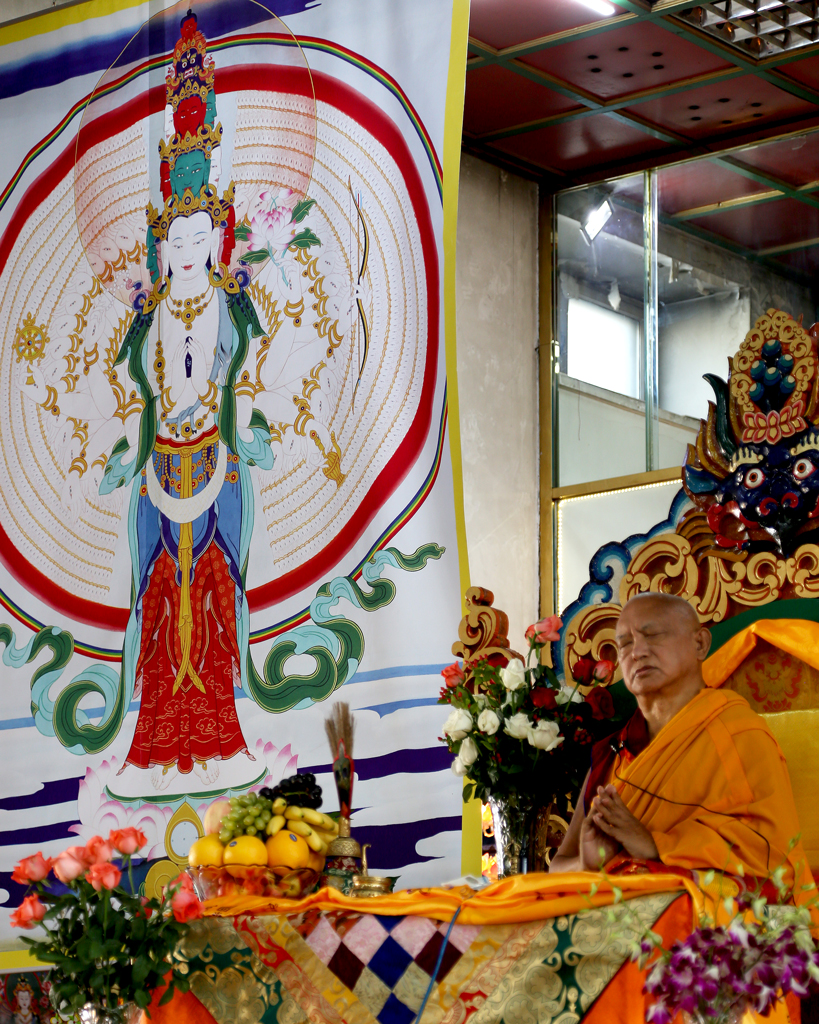
Lama Zopa Rinpoche teaching in front of 1,000 Arm Chenrezig, Ulaanbaatar, Mongolia, August 2014. Photo by Ven. Roger Kunsang.
One of Lama Zopa Rinpoche’s Vast Visions for the FPMT organization is to host 100 Million Mani Retreats (100,000 recitations of 100 million OM MANI PADME HUM) around the world. There are now annual 100 Million Mani Retreats at Ganden Do Ngag Shedrup Ling in Mongolia, Tashi Chime Gatsal Nunnery in Nepal, and a virtual ongoing retreat at Chenrezig Institute, Australia. We are pleased to share the following updates on these retreats, and to rejoice in the billions of mani mantras offered due to these efforts (particularly on this merit-multiplying day of Lhabab Duchen)!
Please note that Chenrezig Institute’s Home Mani Retreat will begin today on Lhabab Duchen (Friday, November 22) and finish on Saka Dawa on Wednesday, June 11, 2025 and all are welcome to join!
Twelve Years of Mani Retreats in Mongolia
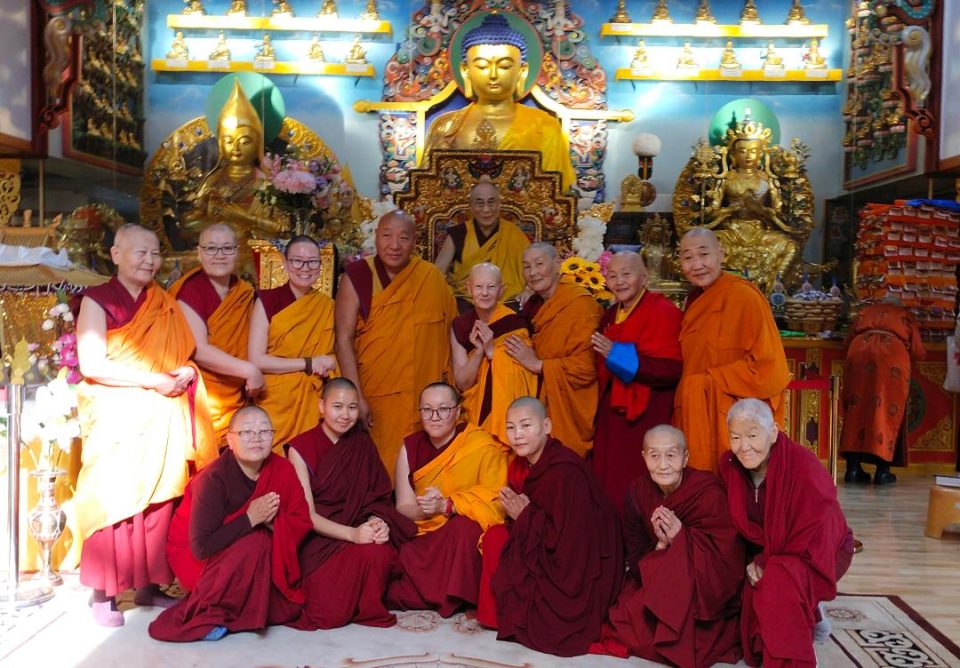
FPMT Mongolia Sangha during the recent 100 Million Mani Retreat, October 2024.
Ganden Do Ngag Shedrup Ling, the FPMT center located in Ulaanbaatar, Mongolia, has reported that during their twelfth annual 100 Million Mani Retreat, held from September 18-October 17, 2024, 100,818,700 mani recitations were accumulated. Ven. Thubten Gyalmo shares the story:
Based on wishes expressed by Lama Zopa Rinpoche in 1999 which encouraged the center to organize and host this event annually, FPMT Mongolia staff have once again, been able to realize this request along with the help of monastic institute partners, volunteers, and students. The retreat has been held consecutively since 2013.
In Rinpoche’s own words, “Since there is a lot of interest in retreats in Mongolia, I especially hope this 100 million Mani retreat will be established and that thousands of people will be able to attend. By doing such a retreat, many people will be liberated, saved from the lower realms and the country where the retreat is held will be blessed …… there will be skies of benefit, especially the development of compassion in people’s minds and benefit to the animals that are killed for food.”
The 2024 Mani Retreat was well attended with more than 250 Mongolians being present on both opening and closing days and numbers of participants from 100-150 attending each day. While most of the manis came from Mongolian people, contributions also came from Indonesia, Malaysia, China, Canada, Poland, and Italy.
Sessions were led by FPMT Mongolia nuns and special teachings on the mantra of compassion, the Chenrezig practice, applying loving kindness in everyday life, the importance of non-harming and environmental awareness, and protection were provided by two guest teachers over several days—Geshe Thubten Soepa from Ganden Monastery in Ulaanbaatar and Geshe Thubten Jampa who was visiting from Drepung in South India.
In addition, many donations were given by students, partners and friends including both cash contributions to help cover the retreat costs and for specific dedications and others which supported purchase of food needed for provision of the daily vegetarian lunches that were served to everyone in attendance.
In accordance with the past guidance of Lama Zopa Rinpoche to dedicate the total of all the manis and merit generated from the retreat to His Holiness the Dalai Lama, a letter was written to His Holiness’ staff in Dharamsala. This included offering the total manis and conveying wishes for a long and healthy life and for the continuation of His Holiness’ most excellent guidance to Buddhist practitioners and others around the world through his own peerless example of compassion, kindness and love.
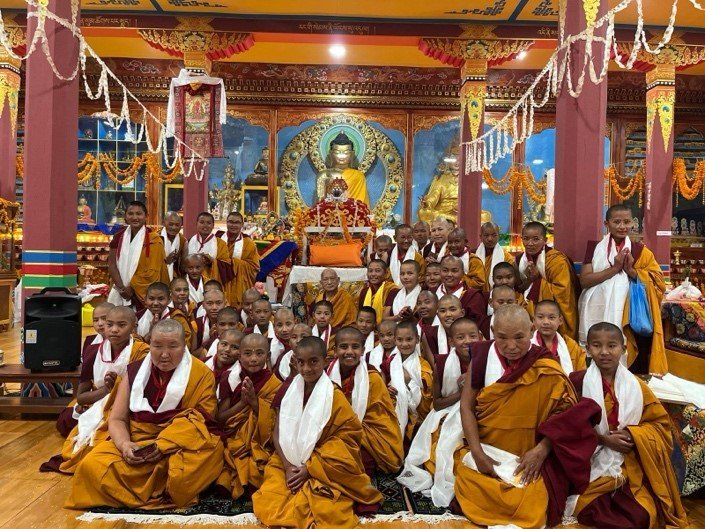
The nuns of Tashi Chime Gatsal Gumba in their new gompa with Lama Zopa Rinpoche in 2022.
Fourteen Years of Mani Retreats at Tashi Chime Gatsal Gumba Nunnery, Nepal
Tashi Chime Gatsal Gumba Nunnery is a small Drikung Kagyu Nunnery in Bigu, Northeastern Nepal. The nunnery has a close connection with Lama Zopa Rinpoche, who visited in 2022 and commented that the nunnery feels like it is in the lap of Mother Tara. Rinpoche directly wished for FPMT to support this nunnery and in turn for the nunnery to dedicate the prayers of 100 million mani recitations (once or twice a year) for the benefit of the FPMT organization. Rinpoche personally set up this arrangement 14 years ago and the Supporting Ordained Sanga Fund sponsors these retreats in order to fulfill Rinpoche’s wish.
To date an incredible twenty-four different 100 million mani retreats have been offered by the nunnery—that is 2.4 billion recitations of OM MANI PADME HUM for the benefit of all beings! Please rejoice! You can read more about support offered to this nunnery.
Twenty-five Years of the Mani Retreat at Chenrezig Institute, Australia
Chenrezig Institute, an FPMT center located in Queensland, Australia, has completed 37,268,600 mani recitations over the past four years; and over the past twenty-four years they have completed an amazing 733,222,700 recitations! Mani Home Retreat Coordinator, Caroline Crossman shares the story:
Back in 2000 when Lama Zopa Rinpoche visited Chenrezig Institute, AUS, he requested the community to conduct an annual Chenrezig Retreat in the manner of the old Tibetan Buddhist traditions in India, Nepal and Tibet and recite 100 million mantras of OM MANI PADME HUM. We have now done this twenty-four times over twenty-four years!
It is with great rejoicing, on behalf of all the participants that we offer 37,268,600 manis that have been recited over the past four years of the Mani Retreat (inclusive of the gompa and home count). Over the twenty-four year period of hosting these Mani Retreats, in total we have recited 733,222,700 manis. Since then, although we have not completed 100 million manis in each retreat, we persevere and understand the most important aspect of the practice is not the number of mantras that are recited but the development of a good heart and a compassionate attitude.
As Rinpoche has said, “It is extremely important for you to recite OM MANI PADME HUM, also the long and short Chenrezig mantra. There is no number for you to recite, just recite as many as you can.”
Our first gompa retreat showed us clearly that even with six weeks of formal retreat we were by no means going to come close to the goal of 100 million recitations. In his great kindness and aware of our extremely busy lifestyles, Rinpoche composed a short practice enabling anyone wishing to participate in the retreat, to do so from the convenience of their own home, hence the Home Mani Retreat was born. From that point onward, Australians from afar and many others internationally have been able to participate and contribute towards the Home Mani Retreat.
With deep gratitude we continue to thank Kyabje Lama Zopa Rinpoche for the wonderful opportunity of being able to do this practice in this manner and strive toward accomplishing his former wishes. The primary focus of this retreat is to promote world peace and the recited mantras are especially dedicated to the long life of His Holiness the Dalai Lama, all of our precious Dharma teachers, the recognition of the unmistaken incarnation and swift return of Kyabje Lama Zopa Rinpoche, for all of his Dharma wishes to be immediately fulfilled and for the success of all his holy projects throughout the world.
Over the years there have been many formal gompa retreats and in particular we wish to thank our dedicated Sangha retreat leaders including Geshe Lobsang Jamyang, Ven. Ailsa Cameron, Ven. Tenzin Tsapel, Ven. Tsepel, Ven. Tencho, Ven. Lhamo, Ven. Yonten, Ven. Lozang, Ven. Tsultrim, and Ven. Thubten Pema as well as the many gompa and the home retreat participants.
From the side of the Home Mani Retreat there have been approximately 44 Dharma centers and groups who have contributed. There have been approximately 70 Sangha and more than 800 lay individuals world-wide who have contributed to the accumulation of manis from twenty-two countries. Some have contributed one mala of manis and others have contributed millions of mantras. We are grateful to everyone who has been involved.
In the past, the home retreat has run for 6-8 months from the Wheel Turning Day of Buddha’s Descent from Tushita (Lhabab Duchen) through Saka Dawa of the following year. This year for the twenty-fifth year, the Home Mani Retreat will begin on Friday, November 22 and finish on Saka Dawa on Wednesday, June 11, 2025 or when 100 million is achieved, whichever comes first.
If you wish to participate in the Home Mani Retreat, please use the following link to complete your interest/registration for participation. Everyone is very welcome!
Through our participation in the Mani Retreat may the compassionate spirit of love increase within us all so that we may quickly complete the Enlightenment Path and realize our own clean-clear blissful Avolokiteshvara Buddha nature. Thank you all so much.
Please rejoice in the incredible effort of so many to offer these 100 Million Mani Retreats as a way to generate unbelievable merit for the FPMT organization, for the fulfillment of Lama Zopa Rinpoche’s Vast Visions, and for the cultivation of loving-kindness in the hearts of all.
Foundation for the Preservation of Mahayana Tradition (FPMT), is a Tibetan Buddhist organization dedicated to the transmission of the Mahayana Buddhist tradition and values worldwide through teaching, meditation and community service.
- Tagged: 100 million mani retreat, bigu nuns, chenrezig institute, ganden do ngag shedrup ling, tashi chime gatsal nunnery
15
Please Enjoy Our November 2024 e-News
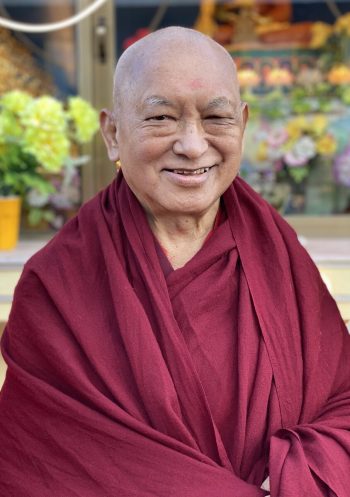
Lama Zopa Rinpoche at Kopan Monastery, January 2020. Photo by Ven. Roger Kunsang.
This month’s e-news brings you important news, updates, and causes for rejoicing including:
- Teachings from Lama Zopa Rinpoche and Lama Yeshe
- News About the Second Anniversary Pilgrimage to Lawudo
- Support offered to 1,500 students in India and Nepal in 2024
- An inspiring update on the Malaysian centers
- Geshe Doga offering 40 years at Tara Institute
- Completion of the 12th annual mani retreat in Mongolia
- An update on regional consultations and foundation service seminars
- Resources and opportunities for your study and practice
- Changes and opportunities in the organization
And so much more!
Please read this month’s e-news in its entirety.
Visit our subscribe page to receive the monthly FPMT International Office e-News directly in your email inbox.
Foundation for the Preservation of Mahayana Tradition (FPMT), is a Tibetan Buddhist organization dedicated to the transmission of the Mahayana Buddhist tradition and values worldwide through teaching, meditation and community service.
- Tagged: enews, fpmt enews
14
Ven. Roger Kunsang’s Inspiring Visit to Malaysia
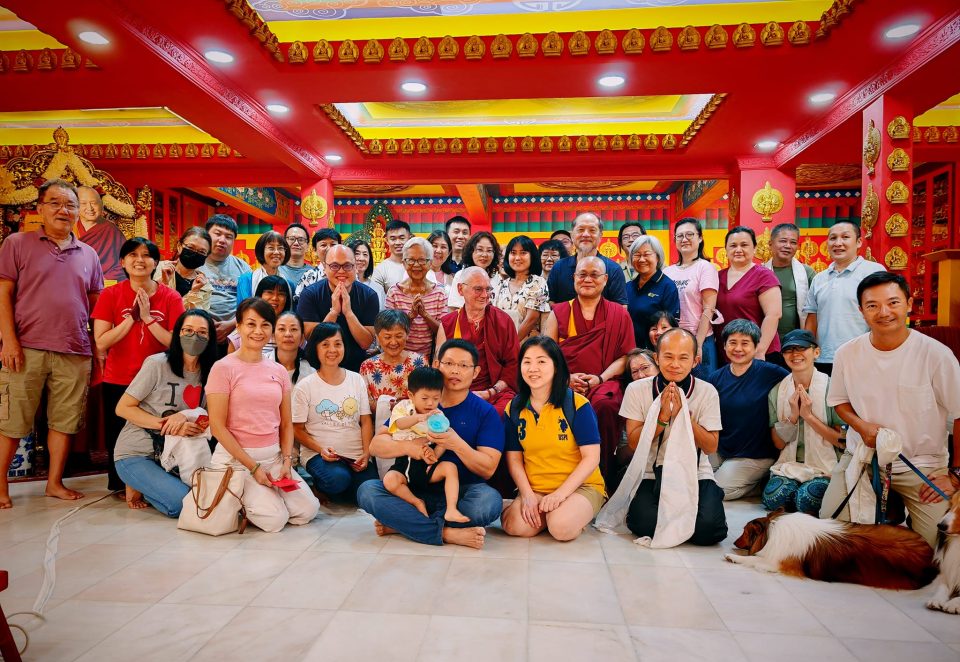
Ven. Roger with Losang Dragpa Centre members in Kuala Lumpur.
In October Ven. Roger Kunsang, CEO of FPMT Inc. and longtime attendant to Lama Zopa Rinpoche, met with all three FPMT entities in Malaysia to engage with the communities, receive updates on their various plans and projects, and share stories about Lama Zopa Rinpoche and FPMT. FPMT East & Southeast Asia regional coordinator, Selina Foong, shares details of this special visit:
Ven. Roger’s Malaysia stopover in early October was the very definition of a whirlwind tour—what with fruitful visits to all three FPMT Malaysia centers, interactions with students both new and old, and endless piles of delicious (and spicy) local food, including durian!
The first stop was at Losang Dragpa Centre (LDC) in Kuala Lumpur, where members and friends packed into the gompa to enjoy a buffet dinner before settling down for a special session with Ven. Roger, introduced by Centre Director Goh Pik Pin, myself (FPMT East & Southeast Asia regional coordinator), and moderated by Trustee Lee Oi Loon.
All were enthralled by Ven. Roger’s recounting of some extraordinary experiences with Kyabje Lama Zopa Rinpoche. One particular story was about one time in the 1980s at the Nepal-India border, where Rinpoche and Ven. Roger had been dropped off and then Rinpoche decided to get on a bus. With no clue as to where they were heading, Ven. Roger of course had to follow, lugging along two heavy suitcases filled to the brim with holy texts that Rinpoche never traveled without. The bus was packed, and they both sat to the side of the driver, blasted by the night air as the bus was missing a windscreen(!). Suddenly, Rinpoche asked the driver to stop. In pitch dark and in the middle of nowhere, Rinpoche got off the bus with Ven. Roger struggling behind him, loaded down by the two suitcases. They eventually left the road and continued into the bush, going down a gully, across a creek, and up again on the other side (by this stage, even the LDC audience was sweating!) …. until finally, faint lights appeared in the distance. “There!” Rinpoche exclaimed. It was the monastery of His Eminence Chobgye Trichen Rinpoche, one of Rinpoche’s teachers. Retiring for the night at last in a hot and tiny room, Ven. Roger quickly sank into an exhausted sleep while Rinpoche continued his prayers. At around 1-2 a.m., Ven. Roger awoke to find Rinpoche had lifted off the mosquito net as well as his singlet. His entire torso was covered with mosquitos! “I was really shocked,” Ven Roger recalled … but Rinpoche was of course unfazed. “It’s okay, it’s okay! They are only taking a little bit of blood each,” came Rinpoche’s soothing reply.
As the stories continued to flow, listening to them first-hand was simply spellbinding. But then came the question on everyone’s minds: How did Ven. Roger himself keep going at this intensity for almost forty years? He said the answer one day spontaneously came to him about Rinpoche, “This is the bodhisattva’s way of life!” The phrase just tumbled out of Ven. Roger’s mouth. He realized then and there the purity and bodhichitta emanating from Rinpoche’s every pore. This was what compelled him to assist Rinpoche, in any way he could, without ever giving up. How moving and extraordinary.
Ven. Roger shared that he also had a long and excellent discussion with LDC’s resident Geshe, Geshe Jampa Tsondu, about the ongoing FPMT Basic Program offered online to all students which began in October 2020. With a solid and consistent following, two different subjects are taught concurrently, to cater to varying levels of students. The students are also benefiting enormously from the 20-30 minute meditation session led by Geshe Tsondu at the beginning of each class, as well as the regular quizzes and weekly review classes to foster deeper understanding of the topics taught.
In fact, Geshe Tsondu shared how he considers that out of all Rinpoche’s exalted activities, the FPMT Basic Program and Masters Program established by Rinpoche are among the greatest. Therefore, due to Rinpoche’s great kindness, these programs will help the Dharma to flourish for a very long time, for the benefit of many. It is LDC’s hope to offer the FPMT Masters Program in the future; something to truly rejoice in and look forward to!

Ven. Roger with members of Chokyi Gyaltsen Center.
From Kuala Lumpur, Ven. Roger flew to Penang and was received at the Penang International Airport by Chokyi Gyaltsen Center (CGC)’s resident Geshe, Geshe Tenzin Deyang, and a few committee members. Arriving at CGC, members and friends were already waiting in line to warmly welcome him with khatas in greeting. What a joy to see Ven Roger at the center again after eight long years. His last visit was with Rinpoche in 2016, for the Most Secret Hayagriva Initiation (MSH) program. How much has changed since then!
Ven. Roger’s display of guru devotion at CGC was most inspiring. He offered khata and flowers to Rinpoche’s throne in the gompa, and three full prostrations to Rinpoche’s throne in Rinpoche’s top floor room. Lights were also offered to the many beautiful holy statues.
Geshe Deyang then led prayers to Mother Tara for the swift return of Kyabje Lama Zopa Rinpoche, and it was very moving to see Ven. Roger truly immersed in the prayers. An interactive sharing session followed, with Ven. Roger’s stories of Rinpoche’s enlightened activities and of how Rinpoche would use circumstances in daily life to benefit others. Later, Ven. Roger told Geshe Deyang and center director Lim Eam Lee that he had enjoyed the gompa’s peaceful and solemn atmosphere, and wished he could stay longer and do further prayers there.
CGC had arranged for Ven. Roger to stay at a lovely hotel along Gurney Drive, one of the most popular scenic waterfront promenades in Penang. Before the dinner at a nearby restaurant, CGC’s committee members met Ven. Roger at the hotel, where he gave valuable guidance and much encouragement, explaining why one should very much rejoice in the opportunity to work for the center.
During the visit, Ven Roger also informed Geshe Deyang and Lee of FPMT’s plan to organize a MSH retreat for our global FPMT family, to fulfill Lama Zopa Rinpoche’s wishes and as a way to protect the organization. Ven. Roger then requested Geshe Deyang to lead CGC in hosting this MSH retreat in Penang. How wonderful! CGC is already starting to plan for this special event; more details will be announced in due course.
The final stop was Rinchen Jangsem Ling retreat center (RJL) in Triang, a three-hour drive from Kuala Lumpur two days later. What a physical transformation RJL has undergone since 2016, when Rinpoche last visited and presided over the inaugural three-week Medicine Buddha Retreat! The covid lockdown years have certainly been put to good use, with a new access road, additional parking facilities, new canteen and extra accommodation in various states of completion.
Especially amazing are RJL’s holy objects. Joining the glorious Kwan Yin, Medicine Buddha and Namthose marble statues is the giant Namgyalma stupa, which Rinpoche had advised in 2016 to be built and was swiftly completed just several years later. Rinpoche had also advised and himself donated toward a prayer wheel for RJL’s public Dharma park. This three-story Wish-fulfilling Prayer Wheel is currently in progress, with the concrete foundations already laid. When completed, it will be the largest prayer wheel in the world which is enclosed within a pavilion.

Ven. Roger visiting RJL’s future Thousand Buddha Wall.
Another jaw-dropping project currently in progress at RJL is the Thousand Buddha Wall, which will be the largest Buddha wall in the world when completed. The huge retaining wall serving as its base has already been completed, and strong efforts are ongoing for its detailed design as well as fundraising for these truly amazing holy objects. Wow, rejoice!
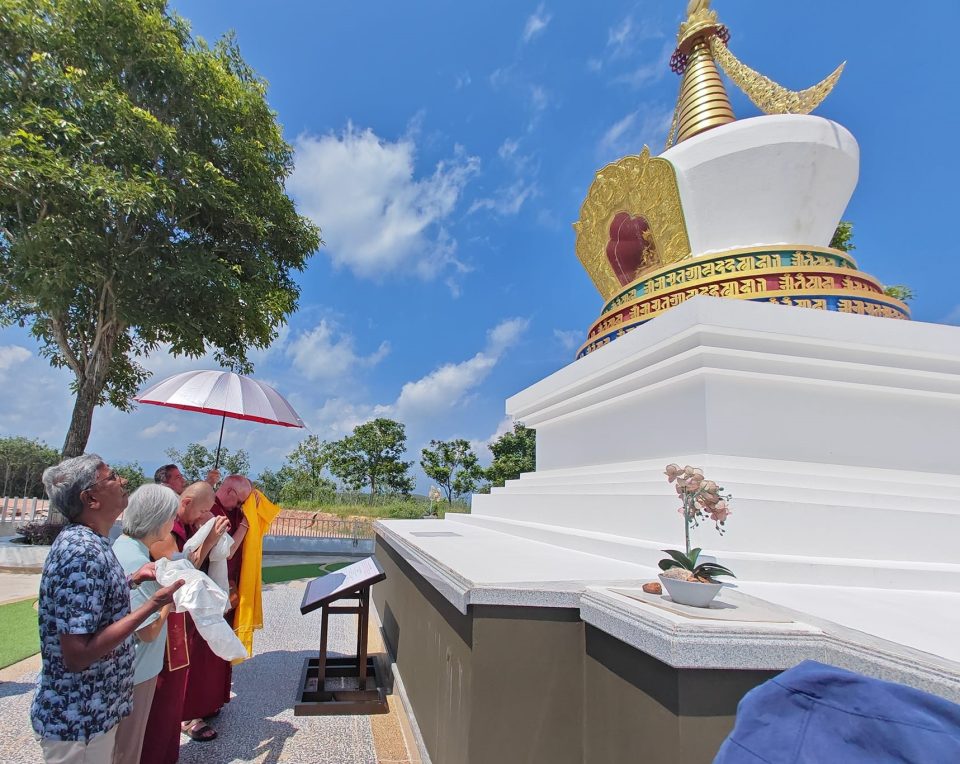
Ven. Roger offering a khata to Rinchen Jangsem Ling’s Namgyalma Stupa. Photo courtesy of RJL.
It was a sweltering day when Ven. Roger visited, but this did not deter him from walking the extensive grounds, viewing the progress of the prayer wheel and Thousand Buddha Wall, and praying before the beautiful statues as well as the recently completed Namgyalma Stupa. No day in Malaysia would seem to be complete without another mountain of flavorsome food and sure enough, everyone enjoyed a sumptuous lunch in the main building, as well as light refreshments at the scenic Bodhi Garden where bamboo pavilions provided welcome respite from the afternoon heat.
All in all, it was a very successful trip. The Malaysian centers felt truly honored to have the opportunity to express their gratitude to dear Ven. Roger, who for almost forty years served our Holy Guru with unflinching devotion and deep humility. Utmost respect to you, Ven. Roger! Thank you for all that you have done, and continue to do! We wish you a long life, good health, and may all your wishes come true.
With grateful thanks to Selina Foong for this report.
Foundation for the Preservation of Mahayana Tradition (FPMT), is a Tibetan Buddhist organization dedicated to the transmission of the Mahayana Buddhist tradition and values worldwide through teaching, meditation and community service.
- Tagged: chokyi gyaltsen center, holy objects, losang dragpa centre, malaysia, rinchen jangsem ling, ven. roger kunsang
13
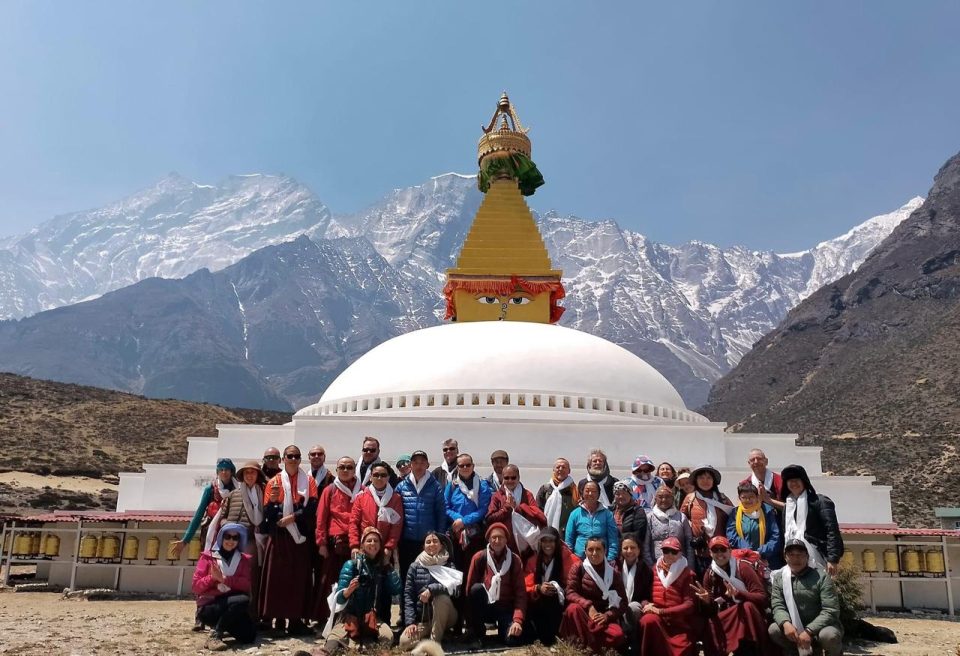
2024 Anniversary Pilgrimage participants gathered at the Thame Stupa, Nepal, May 2024. Photo courtesy of Ven. Sarah Thresher.
Following the success of the first anniversary pilgrimage last year, Lawudo Retreat Center is happy to announce that it will once again be offering the chance to visit, reflect, pray and meditate at the holy places of the Lawudo Lamas on the second anniversary of Rinpoche showing the aspect of passing away. Pilgrims will be able to pray for Rinpoche’s swift return while also absorbing the blessings of these holy places and deepening one’s understanding of the unique Sherpa culture of which Lama Zopa Rinpoche was a part. Dharma talks and discussions will be led by Charok Lama Sherpa Rinpoche and pilgrimage leaders will be Ven. Sarah Thresher and Ven. Angie Muir. Ven. Sarah Thresher shares the details of this most precious opportunity:
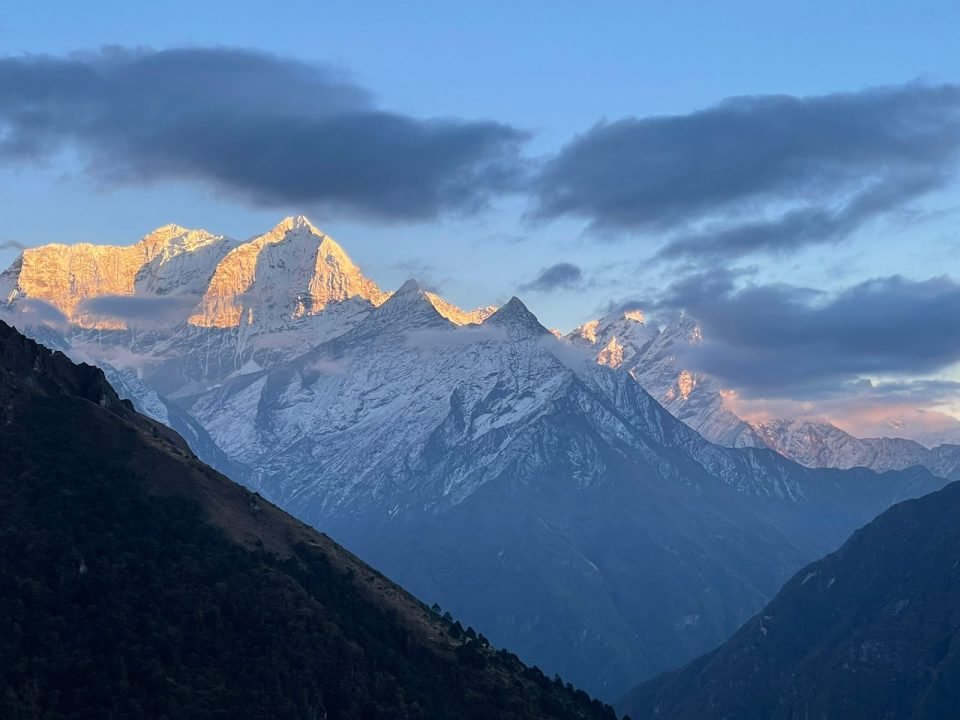
View from the Lawudo Lama’s cave, looking toward Thamserku. Photo by Ven. Sarah Thresher.
Honoring Our Spiritual Master Kyabje Zopa Rinpoche, the Second Lawudo Lama,
On the Second Anniversary of His Passing
By Ven. Sarah Thresher
Pilgrimage is always uplifting—but to visit and practice in the holy places of one’s own teacher is especially powerful and moving. This anniversary pilgrimage to the Khumbu region—and particularly Lawudo—is therefore especially poignant on the second anniversary of Rinpoche’s passing.
The Khumbu region with its soaring mountains, clear skies, roaring rivers, waterfalls and ancient settlements is not just a place of breathtaking beauty, it is also a hidden valley (beyul) blessed by Padmasambhava to nurture and support spiritual practice and realization. Generations of yogis have meditated in its caves and hermitages and the landscape is enriched by the presence of stupas, prayer stones, prayer wheels, prayer flags, holy images, temples and hermitages.

Lama Zopa Rinpoche, Lawudo, Lawudo Retreat Centre, Nepal, 1978. Photo by Ueli Minder. (photographer)
This is where our spiritual master Lama Zopa Rinpoche in his past life as the Lawudo Lama showed the aspect of accomplishing the highest stages of Dzogchen Atiyoga in the Lawudo cave and earth holes around it. It is also where Rinpoche took rebirth in the picturesque village of Thame and first became a monk at Thame monastery. It is where Rinpoche built his first monastery, ordained the first Kopan monks and where his sister still lives. In recent years, Rinpoche also put much effort to help the local people by restoring the huge stupa of Thame-teng, constructing a 100 trillion mantra prayer wheel in Thame and sponsoring the reconstruction of temples, prayer wheels, artwork and more in the surrounding areas.
The Lawudo Anniversary Pilgrimage is an opportunity for students of Lama Zopa Rinpoche to visit and connect (or reconnect) with the holy places of Rinpoche’s past and most recent life as the Lawudo Lama. During these fifteen days of pilgrimage we will be doing prayers and practices taught by Rinpoche and specifically focused on clearing obstacles and creating auspicious conditions for his swift return. There will also be time to reflect, contemplate and absorb the blessings of these inspiring places. For the three days of retreat at Lawudo, Charok Lama Rinpoche will give teachings on the Wheel of Sharp Weapons thought transformation text and there will be prayer sessions throughout the day in Lawudo cave for Rinpoche’s swift return.
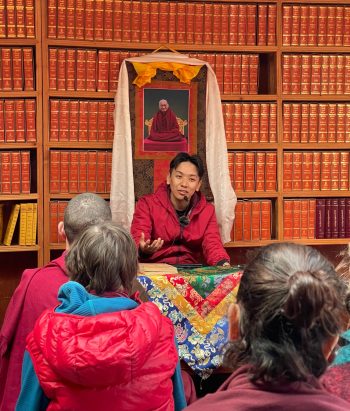
Cherok Lama teaching in Lawudo.
With thanks to Ven. Sarah Thresher for sharing details of the upcoming pilgrimage. Registration is now open for this precious opportunity.
Charok Lama Rinpoche was recognized at the age of three as the reincarnation of the revered hermit-yogi Kusho Mangde who was a friend of the first Lawudo Lama and meditated in the Charok Cave nearby. As a young child he demanded to go to Kopan monastery to study as a monk and from there he attended Sera Monastery, where he excelled in debate and philosophical enquiry. Charok Lama’s early travel and exposure to Eastern and Western culture has given him a special insight into the challenges faced integrating Tibetan Buddhism to other cultures. He is a gifted and joyful Dharma teacher, public speaker and motivational coach.
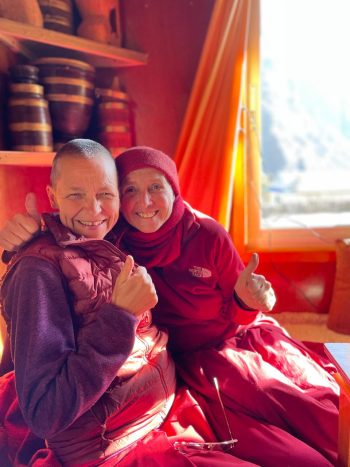
Pilgrimage leaders Ven. Angie Muir and Ven. Sarah Thresher—seen here on pilgrimage together in Thame last year.
Ven. Sarah Thresher met Buddhism in 1982 at Kopan and almost immediately began working for Wisdom Publications editing and preparing Dharma materials. In 1986, after ordaining in Bodhgaya with His Holiness Dalai Lama she made her first trip to Lawudo. She has traveled and taught around the world, but her special focus is preserving and spreading the teachings, practice and chanting lineage of Lama Zopa Rinpoche. In 2023/4 she has spent eight months in retreat and pilgrimage at and around Lawudo and looks forward to sharing the magic of Khumbu with others. Ven. Sarah will be helping to introduce the pilgrimage places and lead the prayers and practices.
Ven. Angie Muir was born in Scotland, in 1970, and obtained a Bachelors Degree in 1992. Feeling disillusioned with her prospective career path and life ahead of her, she left Scotland and combined traveling with work in Asia for three years until in 1995 she felt a calling to go to India to explore meditation and find her life path. Within a few months she met her main spiritual teacher Kyabje Lama Zopa Rinpoche and ordained. Ven. Angie has been a Buddhist nun for over 25 years and during this time, she has served at Lama Zopa Rinpoche’s residences in the USA for 13 years. She shares a love of Rinpoche’s practices and of pilgrimage.
Foundation for the Preservation of Mahayana Tradition (FPMT), is a Tibetan Buddhist organization dedicated to the transmission of the Mahayana Buddhist tradition and values worldwide through teaching, meditation and community service.
- Tagged: anniversary pilgrimage, lawudo, lawudo lama
12
Today we are sharing an upcoming opportunity to join Science & Wisdom LIVE and other FPMT collaborators as they explore secular spirituality, consciousness and the illusion of self in a groundbreaking collaborative event.
On Saturday, November 23, 2024, “Secular Spirituality, The Science of Consciousness, and The Illusion of Self” will unite audiences worldwide in an inspiring online event hosted by Science & Wisdom LIVE, a project of Jamyang London Buddhist Centre. What makes this dialogue truly special is the support from four FPMT entities and their projects, working together for combined results.
The talk invites Geshe Tenzin Namdak, resident teacher at Jamyang Buddhist Centre and Science & Wisdom LIVE, into dialogue with Prof. Thomas Metzinger, a world-renowned philosopher of mind and the cognitive sciences, moderated by Scott Snibbe, author of How to Train a Happy Mind book and host of the similarly named podcast. Together they will explore how secular spirituality can inspire personal growth through meditative and contemplative practices, without needing religious beliefs. The event will also look at the science behind consciousness—how our subjective experiences arise and connect to modern neuroscience. Finally, the idea of the “illusion of self,” a key point in both Buddhist philosophy and cognitive science, will be discussed.
“Secular Spirituality, The Science of Consciousness, and The Illusion of Self” is built on the combined efforts of six dedicated partners: Jamyang Buddhist Centre, Nagarjuna Madrid, Instituto Lama Tsongkhapa, Mind Science Academy, Foundation for Developing Compassion and Wisdom, and Science & Wisdom LIVE itself.
Driven by Geshe Namdak’s vision to make these talks accessible to people from diverse backgrounds, and thanks to the support of Nagarjuna Madrid and Instituto Lama Tsongkhapa, the event will feature live translations in Spanish and Italian, ensuring that non-English-speaking participants can fully engage with the discussions.
As project manager of Science & Wisdom Live, Matthew McArthur, shares, “The collective efforts in planning, promoting, and coordinating this event demonstrate that when organizations come together, they can amplify their impact and create meaningful connections. This partnership not only enhances the event itself but also fosters a sense of community, inspiring others to see the benefits of working together.”
Please read more about this special event on November 23, and find links to register in English, Spanish, or Italian.
Foundation for the Preservation of Mahayana Tradition (FPMT), is a Tibetan Buddhist organization dedicated to the transmission of the Mahayana Buddhist tradition and values worldwide through teaching, meditation and community service.
- Tagged: foundation for developing compassion and wisdom, Instituto Lama Tsongkhapa, jamyang buddhist centre, mind science academy, Nagarjuna Madrid, science and wisdom live
11

Geshe Doga portrait. Photo courtesy of Tara Institute.
Tara Institute, Melbourne, Australia, is extremely honored that Venerable Geshe Doga has been serving as their resident teacher for forty years. Please read their recent report about his kindness, guidance and invaluable teachings spanning four decades:
Staying an astonishing forty years at one FPMT center is an extraordinary accomplishment for any geshe. We at Tara Institute are so grateful to Geshe Doga for his priceless teachings, constant kindness, encouragement, guidance, holding us in his mandala, and putting up with our delusions and petty squabbles for four decades!

Geshe Doga teaching at Kopan Monastery, 1980. Photo courtesy of the Lama Yeshe Wisdom Archive.

Lama Yeshe and Geshe Doga at Kopan Monastery, 1979. Photo by Jeff Nye, courtesy of the Lama Yeshe Wisdom Archive.
It all began in 1980 when Lama Yeshe “poached” Geshe Doga from Sera Je monastery in South India, in order for Geshe Doga to teach young monks in Kopan. Geshe Doga first met Lama Yeshe under the harsh conditions of the Buxa Duar Tibetan refugee camp in India, after escaping Chinese occupied Tibet in 1959.
After a couple of years at Kopan, Lama Yeshe asked Geshe Doga to teach in the West. He kept refusing Lama’s requests because he was happy at Kopan and had no interest in moving to the West. Finally relenting, Geshe Doga came out to Australia on January 1, 1983 to teach in the heat at Atisha Centre in Bendigo (way before the Great Stupa was built).
In late 1983, Geshe-la became the resident teacher of Tara Institute. Uprooted from his culture a second time (first when he escaped Tibet), away from his friends and his monastic traditions—he has steadfastly remained at Tara Institute all these years.
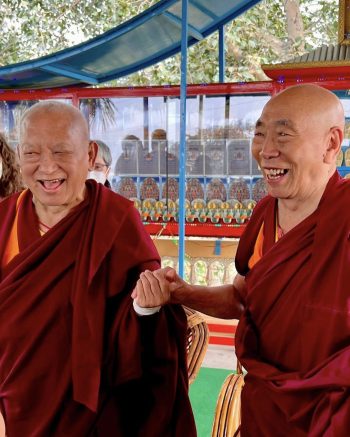
Lama Zopa and Geshe Doga, Bodhgaya, India, 2022. Photo by Cynthia Karena.
From Geshe Doga’s rural beginnings in 1935 in Khanze, a small village in the remote Kham region of northeast Tibet; to dangerous adventures on horseback at 16 years old riding to Lhasa to further his monastic studies; to living in basic conditions in the early days at Sera Je and Kopan monasteries (although far better than Buxa!)—Geshe Doga suddenly found himself living in Australia with all its material wealth and comforts, but also with plenty of untamed minds to work with.
Every time Lama Zopa Rinpoche visited Tara Institute, he asked us to treasure Geshe Doga and to heed his advice. Over the decades, TI has grown enormously, thanks to Geshe-la’s teachings, kindness and patient guidance.
Geshe Doga’s first, and again current, translator at Tara Institute, Sandup Tsering, says Geshe Doga’s friendship with both the late lamas—Lama Yeshe and Lama Zopa Rinpoche—is “very deep, personal and goes a long way. Both the lamas had shown special affection for Geshe-la, and wanted and trusted Geshe-la in their work for flourishing Dharma and benefiting migrating beings through FPMT. Geshe-la has never made any fuss, demands or complaints about his personal needs but wholeheartedly dedicated himself towards the success of the center and FPMT. Geshe Doga was well known in the monasteries in his time as a great debater and a scholar.”
When Geshe Doga first arrived at Tara Institute, we offered long-life pujas for his long and healthy life. Then Lama Zopa specifically instructed us to do five long life pujas for Geshe Doga, and we’ve just kept going, doing them each year for the past twenty-five years, increasing the number of flower garlands and tables with offerings—at least 500 offering bowls resplendent with saffron water, incense, flowers, candles, etc. The community comes together, both as volunteers and attendees, to thank our kind and venerable teacher Geshe Doga for his unwavering commitment and kindness to the students and friends of Tara Institute.
We are also currently fulfilling Lama Zopa’s advice to recite the Sutra of Golden Light 3,000 times for Geshe Doga’s long life. We have had numerous large group recitations at Tara institute and continue to do so, and students continue to recite the sutra at home. The tally at the time of writing is 2,342.
“Geshe Doga is much loved and much admired. There is a genuine equanimity in Geshe-la’s behavior toward others,” says Damien Busby, Monday night teacher and former director, who has been one of the people driving Geshe-la to the various teaching venues around Victoria for many years.
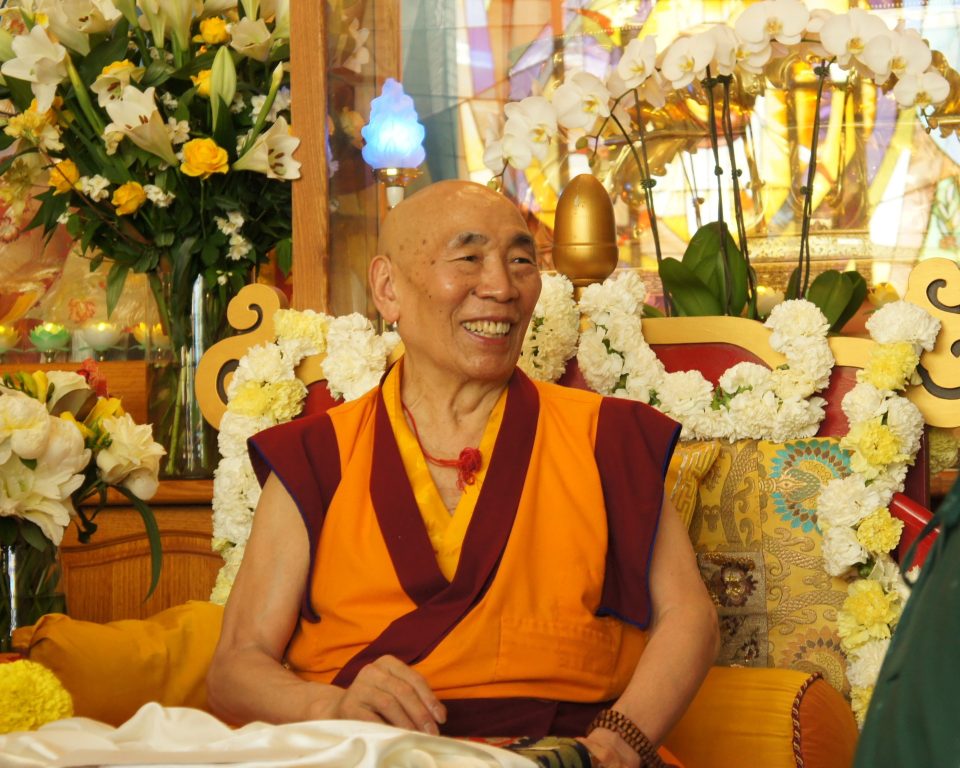
Geshe Doga during a long life puja, 2017. Photo by Damien Busby.
“My own interactions with Geshe Doga feel very precious and valuable over the last forty years. This same care and concern has been extended to hundreds, if not thousands, of others. These interactions are all unique and individual and suited to the needs and personality of the person. This is a remarkable skill and devotion to the welfare of others. Geshe Doga’s devotion to teaching is another extraordinary aspect. Teaching so consistently for over forty years and going wherever he was asked to teach, without question, has seen Geshela teach at more than twenty different locations in Victoria, Tasmania, and New South Wales.”
Student Katrina Moxey says, “His love for teaching Dharma and his unbiased love and compassion for all beings are palpable to anyone who has the fortune to be in his presence. It is no exaggeration to say he has changed my life. Every happiness I experience is directly related to Geshe Doga’s compassionate heart teachings.”
Another former director and long time student, Ross Moore remembers visiting Geshe Doga’s teacher Geshe Ngawang Dhargyey in Sydney in 1985. After asking Ross who his teacher is, Geshe Dhargyey whispered words Ross has never forgotten: “the kindest teacher of all is the one who lives amongst you.”
“This was clearly a reference to Geshe Doga,” Ross explains, “whom I had first met during Kyabje Zopa Rinpoche’s visit to Atisha Centre in 1983, and who was Geshe Ngawang Dhargyey’s own close student.”
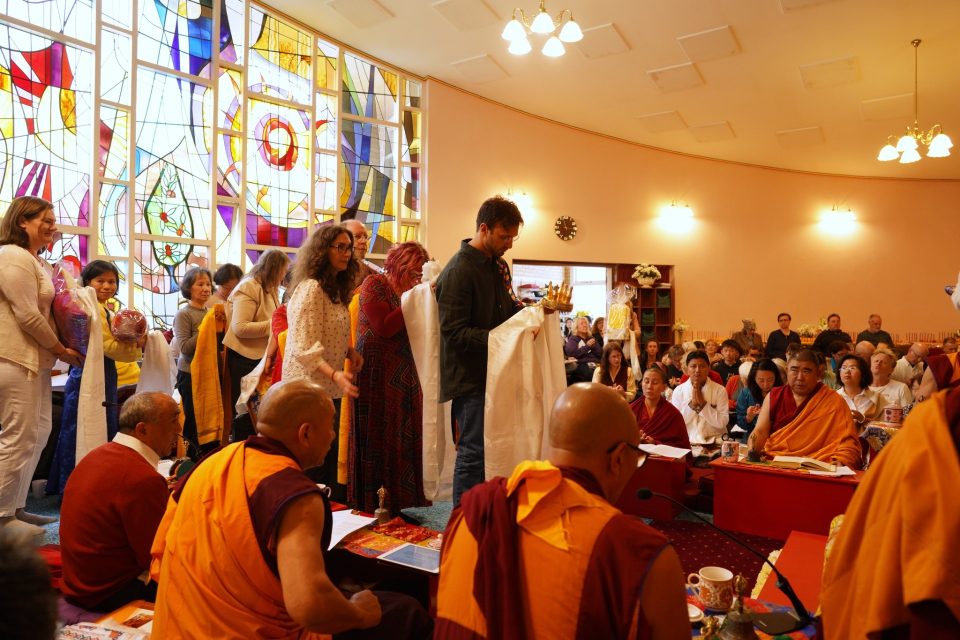
Students in procession during a long life puja for Geshe Doga, 2023. Photo courtesy of Tara Institute.
Over many years, Geshe Doga worked with Lama Zopa Rinpoche to guide Tara Institute, and as Ross says, “all the while quietly and patiently giving teachings of great profundity but also of immense practicality because, without a doubt, Geshe Doga is a real Kadampa master. Of that I have no doubt. It’s extraordinary that Geshe Doga deliberately and skillfully manifests as ordinary so that we can approach him. And he can reach us.”
When visiting Sera Je with Geshe Doga, the great respect for him was evident, says Ross. “But when invited to have his name included in a list of potential Abbots to be presented to His Holiness the Dalai Lama for divination and selection, Geshe Doga repeatedly said no. He would then calmly return to Australia and Tara Institute and continue his teachings from the exact point from where he had left off. It is a truly remarkable fact that Geshe Doga is not only the longest serving geshe in the FPMT organization but has stayed with us.”
Geshe Doga deliberately avoids any perception that he is extraordinary, says Ross. “He is perhaps mistaken by some as being – well – actually ordinary! Such a woeful misreading is a sign that in our own greedy quest for the extraordinary … we gloss over the most remarkable Guru of all – the one manifesting gently and unassumingly dwelling amongst us. A miraculous flower blooming unheralded in the public garden. This miscalculation on our part is surely the height of samsaric folly.”
Although Geshe Doga attended Allys and Dave Andrews’ wedding at Kopan Monastery in 1979, they met Geshe Doga in 1984 when he came to TI. “When family problems arose, his advice would solve them,” remembers Allys. “In times of deep sorrow and great joy, Geshe-la has been there as a guide. One of the greatest gifts he has given me is to have found courage. Quite early on Geshe-la advised me to lead Monday night meditation classes. I was completely terrified for years. Gradually the fear lessened. He is a most precious friend. I have no doubt that Geshe-la is clairvoyant. His view is vast, his advice, whilst sometimes seeming counterintuitive, has solved the most difficult of problems. He has inspired many, many people; at the center, the beach, the swimming pool, in shopping centers. He is amazing. Everything good in my life is a result of following his suggestions.”
We at Tara Institute remain devoted and forever grateful to Geshe Doga. We all resonate with the words Allys shared: “I pray that I will never be separated from him in this and all future lives until enlightenment. Geshe Doga makes awakening seem possible.”
We thank Tara Institute for this moving account of Geshe Doga’s qualities and service, with special thanks to Cynthia Karena, Ross Moore, Damien Busby, Allys Andrews, Sandup Tsering, and Katrina Moxey.
Foundation for the Preservation of Mahayana Tradition (FPMT), is a Tibetan Buddhist organization dedicated to the transmission of the Mahayana Buddhist tradition and values worldwide through teaching, meditation and community service.
- Tagged: geshe doga, tara institute
1
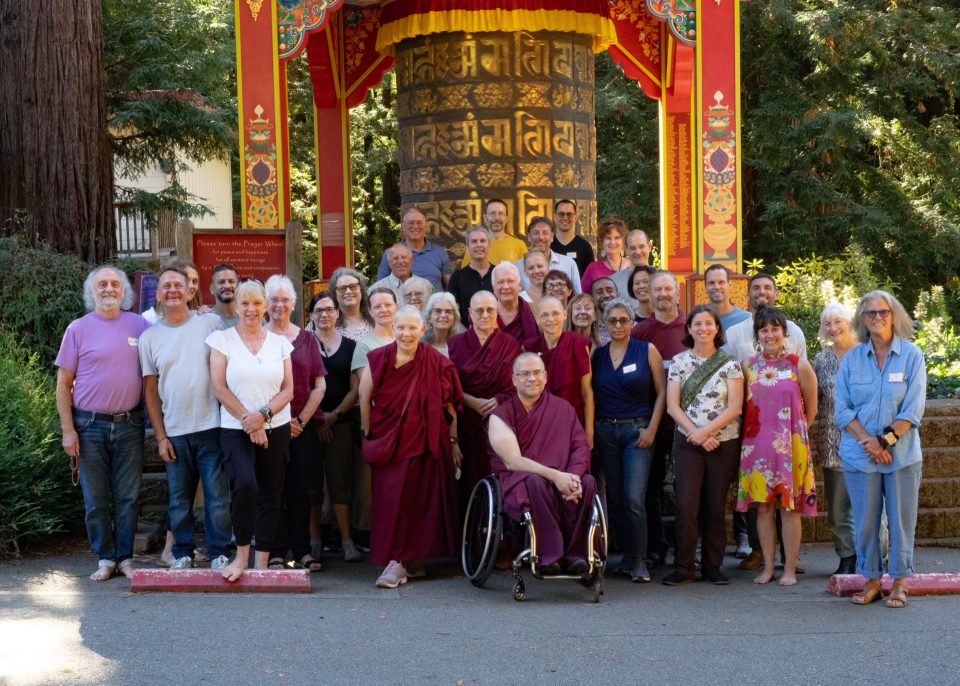
Onsite participants in the FPMT Latin and North America Meeting Regional Consultation at Land of Medicine Buddha. Photo by John Golson.
From September 6-8, 2024 the FPMT North America and Latin America’s 2004 regional consultation was held at Land of Medicine Buddha in Soquel, CA, USA. North American Regional Coordinator, Melissa Kaye, and Director of Thubten Norbu Ling in Santa Fe, NM, Nina Highfill, share the following update on this event which joyfully reunited participants with a shared purpose.
Melissa Kaye reflects: “After five long years of virtual connections, the air was thick with excitement as members of FPMT’s North American region joyfully reunited in person. As I walked into the beautiful, historic Land of Medicine Buddha (LMB) gompa in Soquel, California on the chilly Friday evening, I felt a little uneasy. As the new North American Regional Coordinator, I was not sure whether one weekend would be enough time to break the ice and come together as a region. But the moment I stepped into the room, it was all smiles, hugs and words of welcome and support. The networking and bonding among us began immediately, and there was a palpable sense of belonging and anticipation. We had an eventful weekend in front of us.”
The North American Regional Meeting took place September 6-8, 2024, and was beautifully and expertly hosted by LMB. Representatives from nearly all 27 North American centers, projects, services and study groups attended the hybrid meeting, including 33 in-person participants, some of whom traveled very far to be with us. One participant shared, “Traveling 3,000 miles to be here was worth every moment; the warmth and camaraderie felt like coming home.”’ We also took advantage of technology with more than 20 attending at least some sessions online.
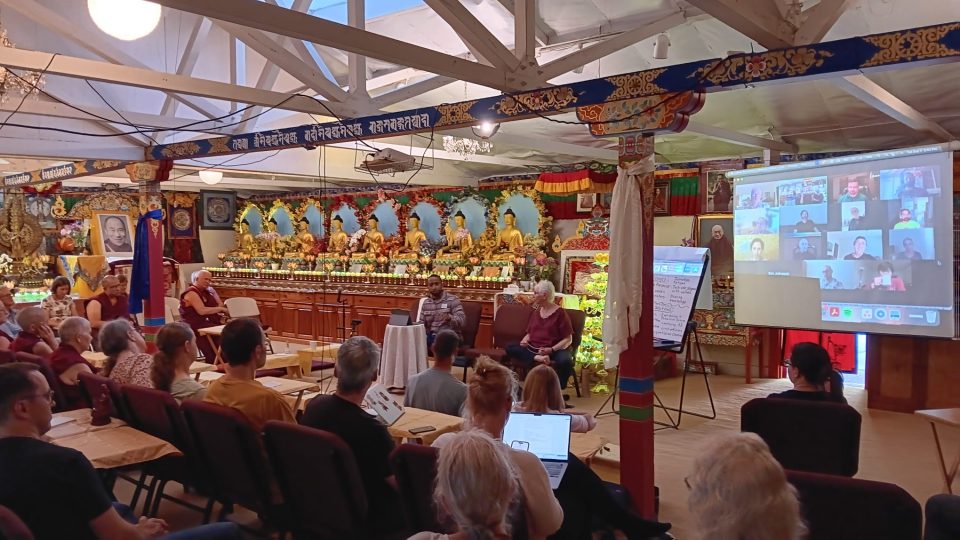
Discussions during the recent NARM meeting at LMB. Photo by François Lecointre
During the first half of the weekend meeting, we were joined by members of the FPMT Inc. Board (Paula de Wys, Dale Davis and Karuna Cayton) and International Office (Teacher/Center Services Director François Lecointre) who led us in discussions on the topic of “Advancing Our Gurus’ Vision of a World Guided by Compassion and Wisdom.” Six members from five centers of FPMT’s Latin America region also joined us online for these discussions, which were part of the FPMT Inc. Board’s regional consultations paving the way to CPMT 2025.
After a Friday night overview of the FPMT Inc. Board’s consultation work completed thus far, Saturday morning saw us diving deep into four crucial areas shaping FPMT’s path forward: Education and Universal Education, Community Services and Interfaith Dialogue, Modern Approaches and Technology, and Leadership.
We broke into small focus groups, each tackling one of these vital topics. The atmosphere was buzzing with energy and ideas, as participants shared insights, debated possibilities and crafted innovative proposals. It was inspiring to witness the collective wisdom of our community at work, each person eagerly contributing their unique perspective to help shape FPMT’s future, even foregoing tea breaks to continue their discussions.
These small group sessions weren’t just theoretical exercises. Our proposals, along those from other regional consultations, will be further refined and consolidated, forming the foundation for deeper explorations at the upcoming CPMT gathering in April 2025. This collaborative process embodies the spirit of co-creation, ensuring that our organization’s future is shaped by the diverse voices of our global community. As one participant aptly put it, “The tone was lovely; everything felt very reciprocal and everyone felt invited to be engaged.” It’s clear that the future of FPMT is in passionate, capable hands.
The second portion of our regional meeting took place on Sunday when we discussed a three-year plan for our region, including ideas for expanding teacher tours, offering region-wide online education programs, modernizing our regional digital content, and increasing center collaboration and training.
Again, there was a great deal of enthusiastic discussion among the participants and tremendous support for expanding regional collaboration and activities. Feedback from the participants included: “Having nearly everyone in person was wonderful. Having breakout sessions to work through topics really helped bond with people from other centers” and “Wonderful to meet fellow FMPT folks from the region, absolutely lovely. Also glad to be able to zoom in to the event and attend at least a small part.”
Throughout the weekend there was an overwhelming sense of new energy and enthusiasm in the room and online. We are so much stronger and can achieve so much more when we work together for the benefit of all sentient beings. And as we were laughing and brainstorming with each other, we realized that offering service together is also a lot more fun!
We look forward to continuing these collaborative discussions and meeting with even more of you next year at Kopan for CPMT 2025!
The last of the four regional consultations planned in 2024 to pave the way for the CPMT 2025 took place at Tara Institute in Melbourne, on October 26 and 27, with representatives, onsite or online from almost all centers, projects, and services from Australia and New Zealand. We look forward to sharing an update on this meeting very soon.
Foundation for the Preservation of Mahayana Tradition (FPMT), is a Tibetan Buddhist organization dedicated to the transmission of the Mahayana Buddhist tradition and values worldwide through teaching, meditation and community service.
- Tagged: fpmt north america
31
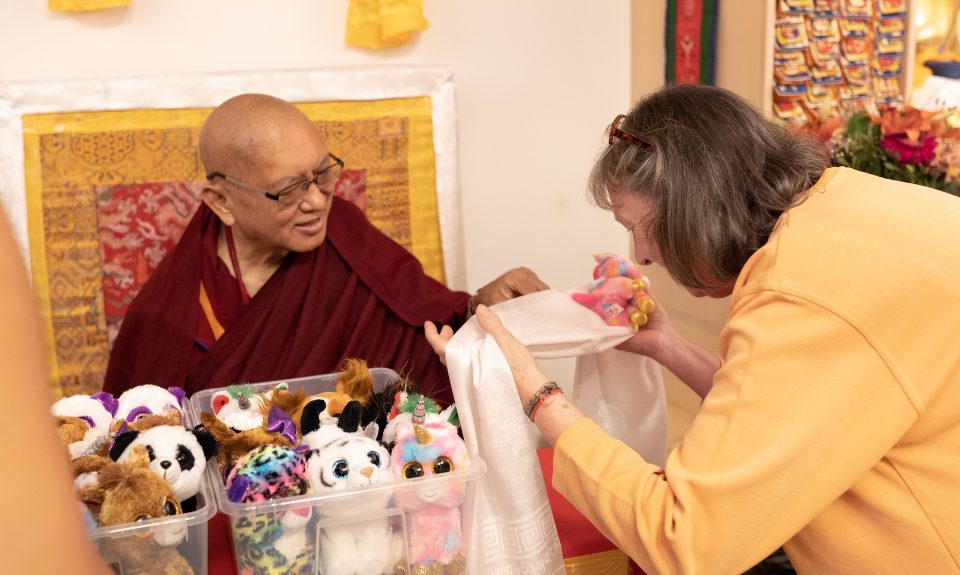
Inge Siebenwurst offering a khata to Lama Zopa Rinpoche in Munich during Rinpoche’s 2018 European Tour. Photo courtesy of Aryatara Institute.
Inge Siebenwurst, passed away on October 22, 2024 in Bavaria, Germany, after a short and serious illness with cancer.
Aryatara Institute submitted a moving obituary for Inge and would like to express their gratitude and appreciation for her. “Inge was a pillar of the Aryatara Institute for many years, her dedication and tireless commitment have made a deep impression and left joyful memories for many members and visitors of the Aryatara Institute.”
A Pillar of the Center
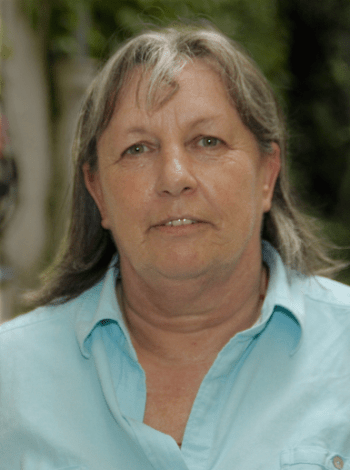
Portrait of Inge Siebenwurst, photo courtesy of Aryatara Institute.
Inge joined the center in 2004, started the Discovering Buddhism course, and soon started volunteering. She didn’t have to be asked, she simply did what was needed. For many years, Inge was at the heart of many practical aspects of our center life. In charge of the preparations, for many years she was the first to open the doors and the last to put out the lights. For 20 years she contributed tirelessly in various capacities.
Spiritual Program Coordinator and Board Member
She proved her organizational skills especially during her time as Spiritual Program Coordinator (2011-2013) and as a core board member (2007-2011 and 2012-2014). In these positions, she played a key role in defining the central topics of the center. Time and again, she impressively demonstrated how important and beneficial personal commitment, good organization and, above all, harmonious cooperation are for spiritual growth and the community.
Major Events and Visits from Lamas
Her commitment to the planning and implementation of major events and teacher visits has been remarkable. She was involved in the Maitreya Loving Kindness Tour (2004, 2008, 2015) and the Sera Lachi and Ngari monk tours (2012, 2015, 2017), and played a key role in the visits of Tenzin Osel Hita (2017), Lama Zopa Rinpoche (2018), Jhado Rinpoche and H.E. Ling Rinpoche (2023), and most recently, in May of this year during the visit of Khandro Tseringma Rinpoche in Munich.
She took on any task that needed to be done, from creating promotional materials, organizing event equipment, driving the teachers, decorating the altar, and much more.
In addition, Inge’s warm-hearted nature and organizational skills not only created a dignified atmosphere for the visiting teachers, but also promoted team spirit and harmony among the many volunteers.
Taking Care of Teachers
Inge’s commitment to the center was evident in the early years when Ven. Fedor came to Munich in 2007 as a Resident Teacher. Wherever she could, she offered her support and was significantly involved in finding a new teacher’s apartment in 2013. She also looked after various visiting teachers such as Ven. Tharchin and Ven. Tony.
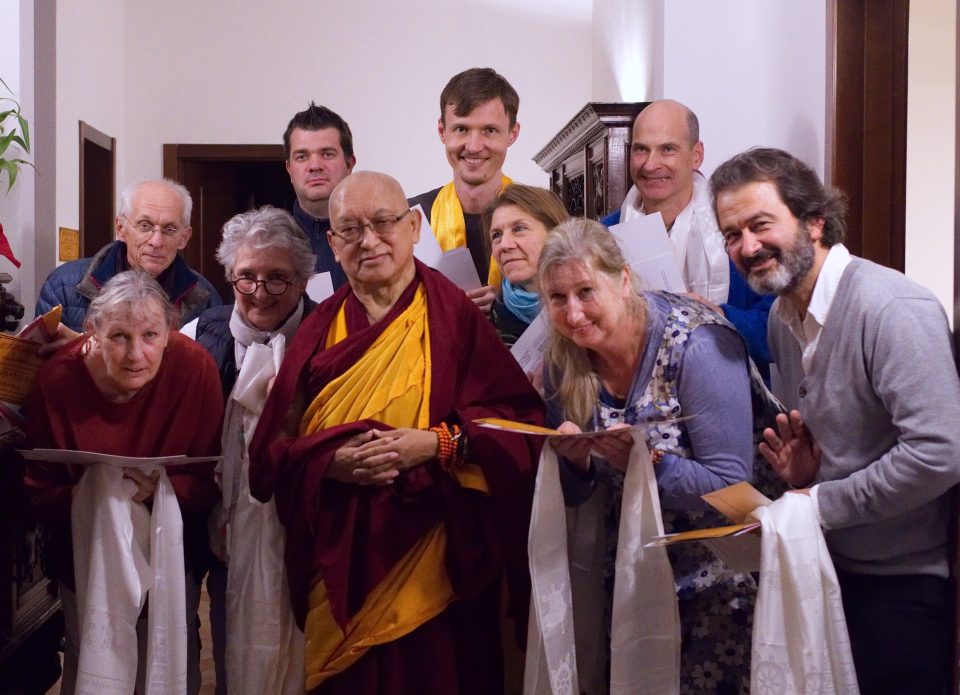
Inge (bottom left) at the100 Million Mani Retreat at ITLK, Italy, 2017. Photo courtesy of Aryatara Institute.
Aryatara Publications
Her extraordinary commitment also showed in the field of publications, where she played a crucial role in publications for over 14 years: as coordinator, layout designer, translator. and proofreader to many essential texts which help to preserve the teachings of Lama Zopa Rinpoche and Lama Yeshe and make them easily accessible to those interested. And to ensure that these publications reach as many people as possible, copies were also sent to German-speaking centers. This too was largely done by Inge, who packed the parcels, took them to the post office, and covered the postage costs without even mentioning it.
Transcription and Distance Learning
With equal dedication, Inge wrote almost 200 transcripts for the FPMT Basic Program and Discovering Buddhism over a period of 12 years—an achievement that is incredibly remarkable in itself. Not only does it require an enormous amount of time (at least 8 hours per transcript) and commitment, but the result—making the words of one’s own teachers available to others so that course participants can read them again and again—is invaluable.
In addition, the transcripts of the lectures of the study programs also form the basis for the distance learning program offered by the Aryatara Institute. For many years, Inge looked after the distance learning students, sent them the teaching materials, answered questions, etc.
Programs, Newsletters, Website
For several years, Inge was responsible for the creation of the programs, the layout of the newsletters and their distribution as well as significantly involved in the creation of the current website, which she also managed for several years.
Leading Events and Retreats
Inge was not only active behind the scenes in many areas, she also led meditations and practices such as the Tsog Guru Puja, as well as Tara and Medicine Buddha practice on a regular basis for many years. She led the Tara Easter retreat for three years, enabling participants to experience the healing practice of Tara in depth. With her empathetic nature, she created a safe space of peace and trust where people could connect and support each other in their practice.
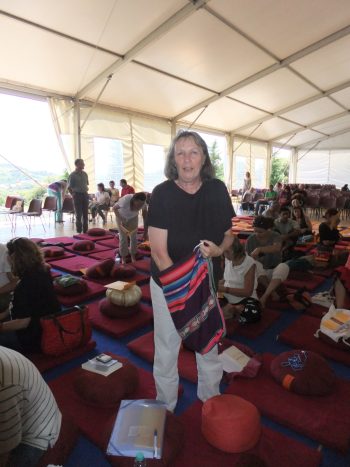
Inge attending retreat in 2014. Photo courtesy of Aryatara Institute.
An Inspiring Practitioner
Inge was not only a tireless volunteer, she was also a long-time student and an inspiring practitioner at the center. She participated in the FPMT Basic Program for Advanced Practitioners, first with Geshe Soepa and later with Ven. Fedor. She devoted herself intensively to the study of profound Buddhist teachings including five years of lamrim study, four years of the Bodhisattvacharyavatara and in-depth study of many other topics and texts. Her interest and dedication to her studies were amazing.
Student of Lama Zopa Rinpoche
Last but not least, she was a truly devoted student of Lama Zopa Rinpoche, whose retreats she attended whenever she could: 2009 in France (6 weeks), 2014 in Italy (3 weeks), 2015 in the Netherlands (2 weeks) and 2017 in Italy (4 weeks). Rinpoche’s visit to Munich in 2018 was certainly a particularly joyful event for her, to the success of which she contributed in the aforementioned way.
Through her manifold but always humble activities for the Aryatara Institute, Inge put into practice one of Lama Zopa Rinpoche’s most important teachings—to understand “service” to others, and especially to Dharma centers, as a path to enlightenment as only when there are places where Dharma is taught can we develop wisdom and compassion. Inge recognized this and for over 20 years she actively supported the center and all those who benefit from it.
A Valued Friend and Companion

Inge with her grandchild, 2022. Photo courtesy of Aryatara Institute.
Inge’s warm nature, her openness for conversation and her ability to inspire and encourage others made her a valued friend and companion to many.
Her work was marked by genuine devotion to the Dharma and a sincere desire to benefit others. Her exemplary tireless dedication, deep practice and genuine commitment will continue to inspire us and be remembered with gratitude. She was a role model for many of us and will remain so.
During the pandemic, Inge moved from Munich to the countryside with her son and daughter-in-law. Her visits to the center became less frequent, but the bond remained. In 2022, her grandson was born, a new task for Inge. As a result of her move, she no longer worked as much for the center, but she saw the support for her family as her practice. She taught her little grandson the mantra OM MANI PADME HUM and showed him how to do light offerings.
Practice for Inge
On Thursday, October 24, 2024, two days after Inge’s death, the Aryatara community performed a Medicine Buddha puja for her at the center. We individually informed people close to her about the puja and around 30 people attended. If you would have liked to be there but were not informed, please accept our apologies. In the short time available and due to our sadness about Inge’s death, we may not have thought of all the people who were also close to her.
All are welcome to offer practice for Inge from home, many resources can be found here, particularly Medicine Buddha practice: Death and Dying: Practices and Resources (fpmt.org/death/).
We would like to note that Inge was also involved in the creation of this information we share with you today. May she continue on the Bodhisattva path with the blessings of the Buddhas and always be guided by perfect Mahayana teachers!
Written by Aryatara Institute, we offer grateful thanks for this inspiring tribute.
Please pray that Inge Siebenwurst may never ever be reborn in the lower realms, may she be immediately born in a pure land where she can be enlightened or to receive a perfect human body, meet the Mahayana teachings and meet a perfectly qualified guru and by only pleasing the guru’s mind, achieve enlightenment as quickly as possible. More advice from Lama Zopa Rinpoche on death and dying is available, see Death and Dying: Practices and Resources (fpmt.org/death/).
To read more obituaries from the international FPMT mandala, and to find information on submission guidelines, please visit our new Obituaries page (fpmt.org/media/obituaries/).
- Tagged: obituaries, obituary
23

Geshe Tsultrim leading the lantern parade at the Big Love Festival. Photo courtesy of CI.
On September 26-28, Chenrezig Institute, the first Tibetan Buddhist Dharma center in Australia, and one of the oldest in the West, celebrated its 50th anniversary serving sentient beings with a joyous Big Love Festival. We are so happy to share this inspiring report of the event from Chenrezig Institute:
Founded in September 1974, Chenrezig Institute was the first Tibetan Buddhist center established outside the Indian subcontinent by The Foundation for the Preservation of the Mahayana Tradition (FPMT). The institute has flourished into a dedicated facility for Buddhist education and practice, where sentient beings can come to learn Dharma, meditate, purify and collect merits.

Closing ceremony of the Big Love Festival for Chenrezig Institute’s 50th anniversary celebration. Photo courtesy of CI.
The Big Love Festival was held on the vast grounds of Chenrezig Institute, between September 26-28. The festival brought together highly respected Buddhist teachers such as resident Chenrezig Institute teacher Geshe Phuntsok Tsultrim, Khenrinpoche Geshe Chonyi, Geshe Tenzin Zopa, Tenzin Osel Hita, two geshemas—including Geshema Namdol Phuntsok, the main teacher and chant leader at Kopan Nunnery—and many other geshes and special guests who facilitated and attended the celebrations from around the world. Furthermore, Ven. Roger Kunsang, the Chief Executive Officer (CEO) of FPMT Inc, attended and oversaw the celebrations and ceremonies throughout the festival.

Sera Je monks working on the Chenrezig sand mandala. Photo courtesy of CI.
Six geshes from Sera Je Monastery attended Chenrezig Institute both before and during the Big Love Festival, offering their precious time and experience. The Sera monks performed a rare and powerful puja before the festival to honor the Dharma protectors and extensive offerings and prayers were given. Before the festival commenced, they worked on the Medicine Buddha sand mandala, and during the festival they constructed the sand mandala of Chenrezig, Buddha of Compassion, in the gompa.

Buddha statue at the new gompa land blessing. Photo courtesy of CI.

Crystal stupa containing Lama Zopa Rinpoche’s holy relics. Photo courtesy of CI.
There were spontaneous and very auspicious moments happening during the three days of the festival.
- On the first day, a Buddha statue from India arrived at the new gompa land, sponsored by a Korean group who were also present. Twenty-seven geshes and all Sangha present offered a blessing ceremony.
- On the second day of the festival, the Kangyur and Tengyur miraculously arrived unexpectedly.
- On the third day, Lama Zopa Rinpoche’s holy relics were placed into a very beautiful crystal stupa that arrived that day. The crystal stupa was hand crafted by artists in China.
Throughout the festival, Tibetan thangka master, Phenpo Tendhar, exhibited a body of artwork in the gompa. He also offered workshops alongside the great artist Pema; both offering their time and skills to support the development of Tibetan art in the West.
Other events throughout the festival included: a Lama Tsongkhapa bhumtsok puja led by Geshe Tenzin Zopa, vibrant Q & A panels, geshe debates and conversations in the Nalanda Masters Garden, guided meditation yoga sessions, Dharma Kids activities in the mornings and the afternoons, inspirational talks, and workshops in the Garden of Enlightenment.
The attendees of the festival rejoiced in a Tibetan songs and dance performance with Topgyal and Tsering, chanting with the Sera Je monks, art displays, live music performances, a Welcome to Country with Aunty Bridgette Chilly Davis, and an impressive lantern parade light offering at dusk, culminating with a beautiful evening concert with Sacred Earth.

Lama Tsongkhapa bumtsok puja. Photo courtesy of CI.
The event not only honored the institute’s legacy but also reinforced its commitment to nurturing compassion and wisdom in the hearts of attendees, bringing together a diverse community united in celebration of love, peace, and spiritual growth.
With grateful thanks to Chenrezig Institute’s director, Cheng Hong Quek, and acting SPC Thubten Kunphen, for providing the details of this joyful celebration.
Are you an FPMT center, study group, or project that has a joyful or inspiring story to share with the FPMT community? We’d love to hear it!
Foundation for the Preservation of Mahayana Tradition (FPMT), is a Tibetan Buddhist organization dedicated to the transmission of the Mahayana Buddhist tradition and values worldwide through teaching, meditation and community service.
- Tagged: 50th anniversary, chenrezig institute
18
October 2024 e-News is now Available!
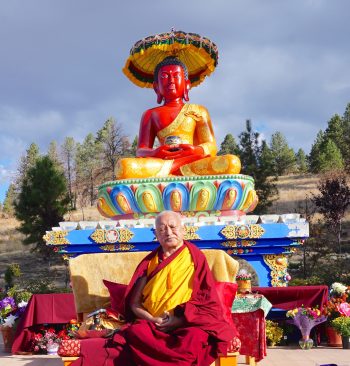
Lama Zopa Rinpoche offering a teaching before the 2016 Amitabha Buddha Festival, Buddha Amitabha Pure Land, Washington State, USA. Photo by Ven. Lobsang Sherab.
This month’s e-news brings you important news, updates, and causes for rejoicing including:
- An update on the Stupa of Complete Victory
- Teachings from Lama Yeshe and Lama Zopa Rinpoche
- An update from the FPMT Board of Directors
- Newly available and revised materials for your practice
- News on the recent Amitabha Buddha Festival in Washington State
- Grants for healthcare and essential services in 2024
- Changes and opportunities within the FPMT organization
- An update on Land of Medicine Buddha’s 100,000 Stupa project
- How to help the devastating situation in Thame
And so much more!
Please read this month’s e-news in its entirety.
Visit our subscribe page to receive the monthly FPMT International Office e-News directly in your email inbox.
Foundation for the Preservation of Mahayana Tradition (FPMT), is a Tibetan Buddhist organization dedicated to the transmission of the Mahayana Buddhist tradition and values worldwide through teaching, meditation and community service.
- Tagged: enews, fpmt enews
11
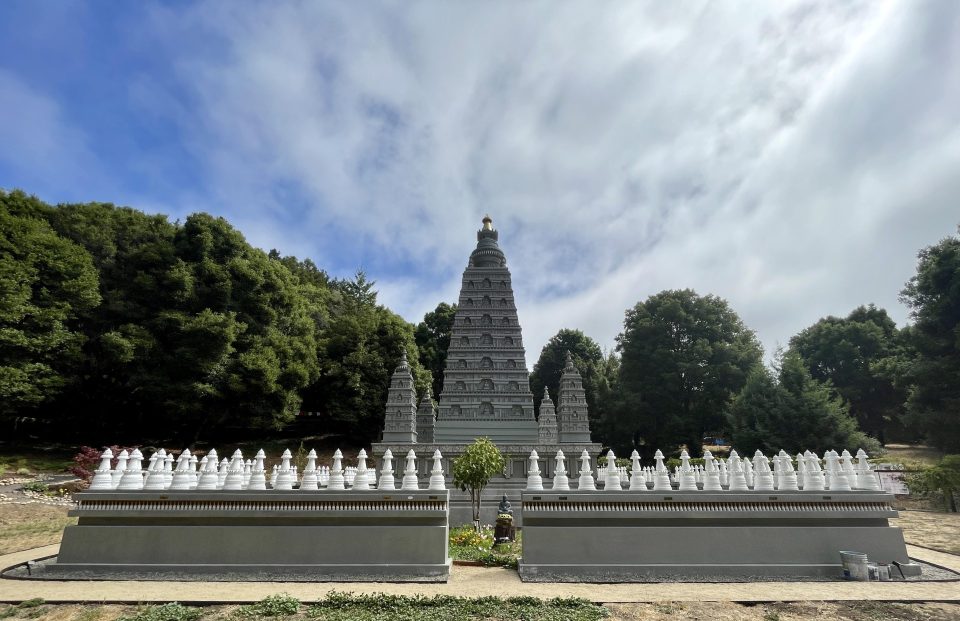
Mahabodhi Stupa with the row of Kadampa stupas, from the back. Photo courtesy of the 100,000 Stupa Project.
On the advice of Lama Zopa Rinpoche, Land of Medicine Buddha (LMB) has been building a 39-foot-tall Mahabodhi Stupa in California. This stupa will be the main attraction of the 100,000 Stupa Project in a beautiful garden featuring an area to meditate, thousands of memorial stupas, places to perform prostrations, and areas with spots for reflection and contemplation. This is a project first conceived by Rinpoche in the late 90s, and breaking ground in 2014 to begin construction. We recently received some exciting updates from Project Manager Denice Macy on this incredible holy object project and we invite you to read the below report and rejoice!
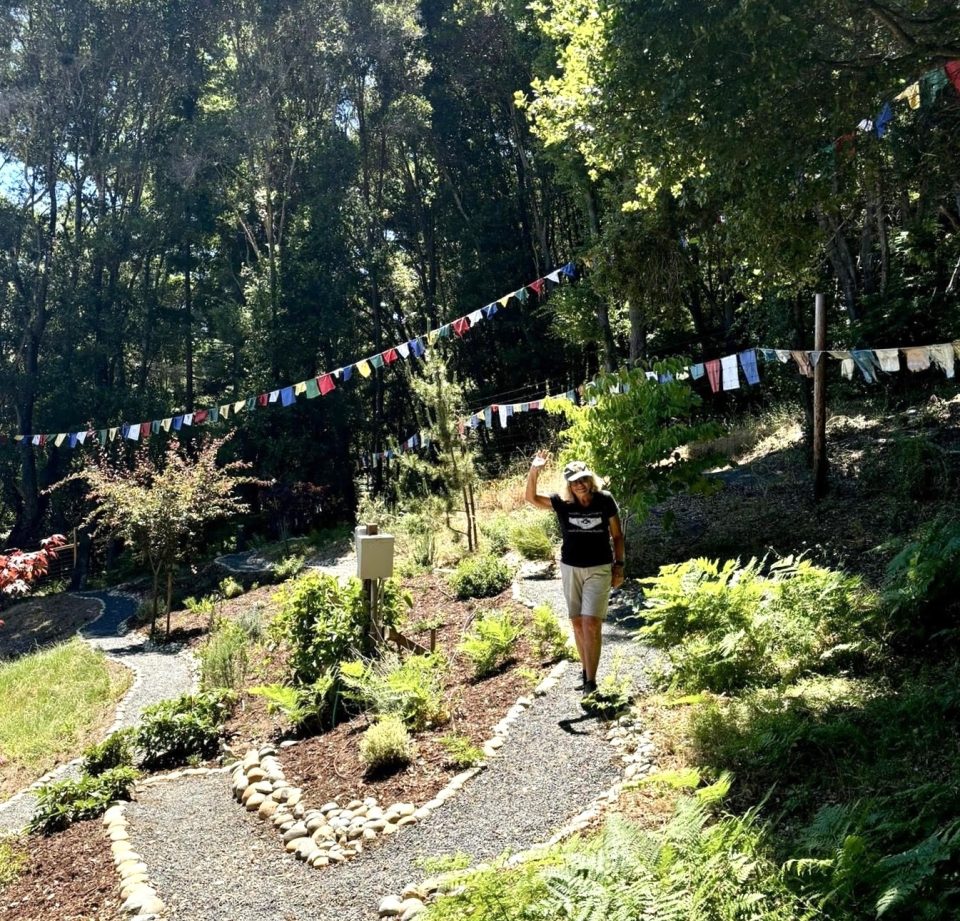
Project Manager Denice Macy waves from the grounds of the Stupa Project.
What Was Accomplished from 2020 to Present
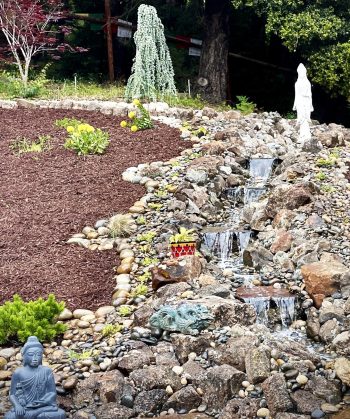
River of Nectar. Photo courtesy of the 100,000 Stupa Project.
Fulfilling two of Lama Zopa Rinpoche’s pieces of advice:
- Garden/grounds: A River of Nectar flows! When Rinpoche came to inspect the Stupa Project in 2019, he discussed with the Project Manager, Denice Macy, ideas for beautifying the grounds. Before the 2019 visit, Rinpoche had mentioned that a Japanese style of garden would be pleasing. As Rinpoche and Denice discussed ideas for landscaping, Rinpoche expressed the wish for a river with mantras placed inside to bless any beings who drink or touch the water. With input from feng shui master Peter Lung, a River of Nectar arose. Water flows slowly down the hillside, over six mini waterfalls. At each waterfall is placed a stone carved with the OM MANI PADME HUM mantra. The mantra stones are carved in six languages: Tibetan, English, Chinese, Vietnamese, Hindi, and Mongolian. Statues, dragons, and other animals—from Lama Zopa Rinpoche’s house in Aptos—were placed along the banks of the river.
- Lighting the Stupa: Following Rinpoche’s advice, colored lights in the four directions were installed during Losar this year and offered every evening as well as blue lights inside the shrine. The five color lights correspond to the colors of the five tathagatas.
Work on the Stupa continues:
- Main Stupa: Gelek Sherpa continues to apply decorative panels to our Mahabodhi Stupa. All the scaffolding have been removed and he is currently working on the ground level preparing thirty-six niches where Buddhas and Taras will reside.
- Large Kadampa Stupas: This summer we completed the casting, filling, and mounting of the large Kadampa stupas on our first mandala wall – 146 stupas in. Of these, approximately fifty stupas remain available for sponsorship. This year we have opened opportunities for stupa reservation in advance. Several stupas have been reserved with two that include not only the blessed ashes of the stupa sponsor, but also of their dog!
- Small Kadampa Stupas: Our mandala wall was built to hold many stupas, with four horizontal niches running lengthwise to house five-inch stupas. We received the first batch of 1,200 five-inch Kadampa stupas in 2023. We held two mantra rolling parties to create mantra rolls of the Four Dharmakaya Relic Mantras and filled these stupas with mantras and incense. These small stupas have been mounted on the mandala wall. Sponsors names will be written on a sign at the stupa site. Of these +1,000 stupas we have found sponsors for 300 stupas. Rejoice!

Shakyamuni Buddha and Green Tara statues which will be placed in all the niches on the ground floor of the Mahabodhi Stupa. Photo courtesy of the 100,000 Stupa Project.
What is Planned for 2025 and Beyond
- Main Stupa: Buddhas and Taras, oh my! Big News! This year we sought advice on the type of statues to place in the niches on the ground floor of our Mahabodhi Stupa. Thankfully, Venerable Roger was able to consult Khandro-la (Rangjung Neljorma Khadro Namsel Drönme), who advised: “It is very good if you have in all the spaces (niches) Buddha Shakyamuni in one and next Green Tara, so alternate these two statues in all the ‘niches’ available. This is very good, especially for the success, quick success, of Lama Zopa Rinpoche’s Holy Wishes.” With the invaluable help of Kabir from Root Institute, we were able to enlist Ratnakar, a talented sculptor in Rajasthan, India, to create eighteen sculptures each of Shakyamuni Buddha and Green Tara. We anticipate the statues will be ready to ship to us in January 2025. The statues then will be mounted onto the niches with a verse placed beneath. We will be opening up sponsorship opportunities for these Buddhas and Taras in the coming year.
- Completion of the Main Stupa: We anticipate the main stupa will be completed in the fall of 2026.
- Enshrinement and Consecration: We are thrilled over the moon to hear that our Mahabodhi Stupa will be the home of the holy tooth relics of our most precious Lama Zopa Rinpoche in the America continent. Venerable Roger wishes that we have a grand consecration once the Mahabodhi Stupa is complete and we are ready to enshrine Rinpoche’s holy tooth relic. We will be inviting lamas, benefactors, and students from around the world for a day of blessings and rejoicing.
One of Lama Zopa Rinpoche’s Vast Visions is to have 100,000 stupas around the world and we rejoice in being a part of fulfilling his holy wish.
With grateful thanks to Denice Macy for this inspiring report!
Learn more about the 100,000 Stupa Project: https://landofmedicinebuddha/100000-stupa-project/
Foundation for the Preservation of Mahayana Tradition (FPMT), is a Tibetan Buddhist organization dedicated to the transmission of the Mahayana Buddhist tradition and values worldwide through teaching, meditation and community service.
- Tagged: holy object, land of medicine buddha, stupas, vast visions
- Home
- News/Media
- Study & Practice
- About FPMT Education Services
- Latest News
- Programs
- New to Buddhism?
- Buddhist Mind Science: Activating Your Potential
- Heart Advice for Death and Dying
- Discovering Buddhism
- Living in the Path
- Exploring Buddhism
- FPMT Basic Program
- FPMT Masters Program
- FPMT In-Depth Meditation Training
- Maitripa College
- Lotsawa Rinchen Zangpo Translator Program
- Universal Education for Compassion & Wisdom
- Online Learning Center
- Prayers & Practice Materials
- Overview of Prayers & Practices
- Full Catalogue of Prayers & Practice Materials
- Explore Popular Topics
- Benefiting Animals
- Chenrezig Resources
- Death & Dying Resources
- Lama Chopa (Guru Puja)
- Lama Zopa Rinpoche: Compendium of Precious Instructions
- Lama Zopa Rinpoche: Life Practice Advice
- Lama Zopa Rinpoche Practice Series
- Lamrim Resources
- Mantras
- Prayer Book Updates
- Purification Practices
- Sutras
- Thought Transformation (Lojong)
- Audio Materials
- Dharma Dates – Tibetan Calendar
- Translation Services
- Publishing Services
- Teachings and Advice
- Find Teachings and Advice
- Lama Zopa Rinpoche Advice Page
- Lama Zopa Rinpoche: Compendium of Precious Instructions
- Lama Zopa Rinpoche Video Teachings
- ༧སྐྱབས་རྗེ་བཟོད་པ་རིན་པོ་ཆེ་མཆོག་ནས་སྩལ་བའི་བཀའ་སློབ་བརྙན་འཕྲིན།
- Podcasts
- Lama Yeshe Wisdom Archive
- Buddhism FAQ
- Dharma for Young People
- Resources on Holy Objects
- Ways to Offer Support
- Centers
- Affiliates Area
- Teachers
- Projects
- Charitable Projects
- Make a Donation
- Applying for Grants
- News about Projects
- Other Projects within FPMT
- Support International Office
- Projects Photo Galleries
- Give Where Most Needed
- FPMT
- Shop
Translate*
*powered by Google TranslateTranslation of pages on fpmt.org is performed by Google Translate, a third party service which FPMT has no control over. The service provides automated computer translations that are only an approximation of the websites' original content. The translations should not be considered exact and only used as a rough guide.It is necessary to help others, not only in our prayers, but in our daily lives. If we find we cannot help others, the least we can do is to not harm them.







